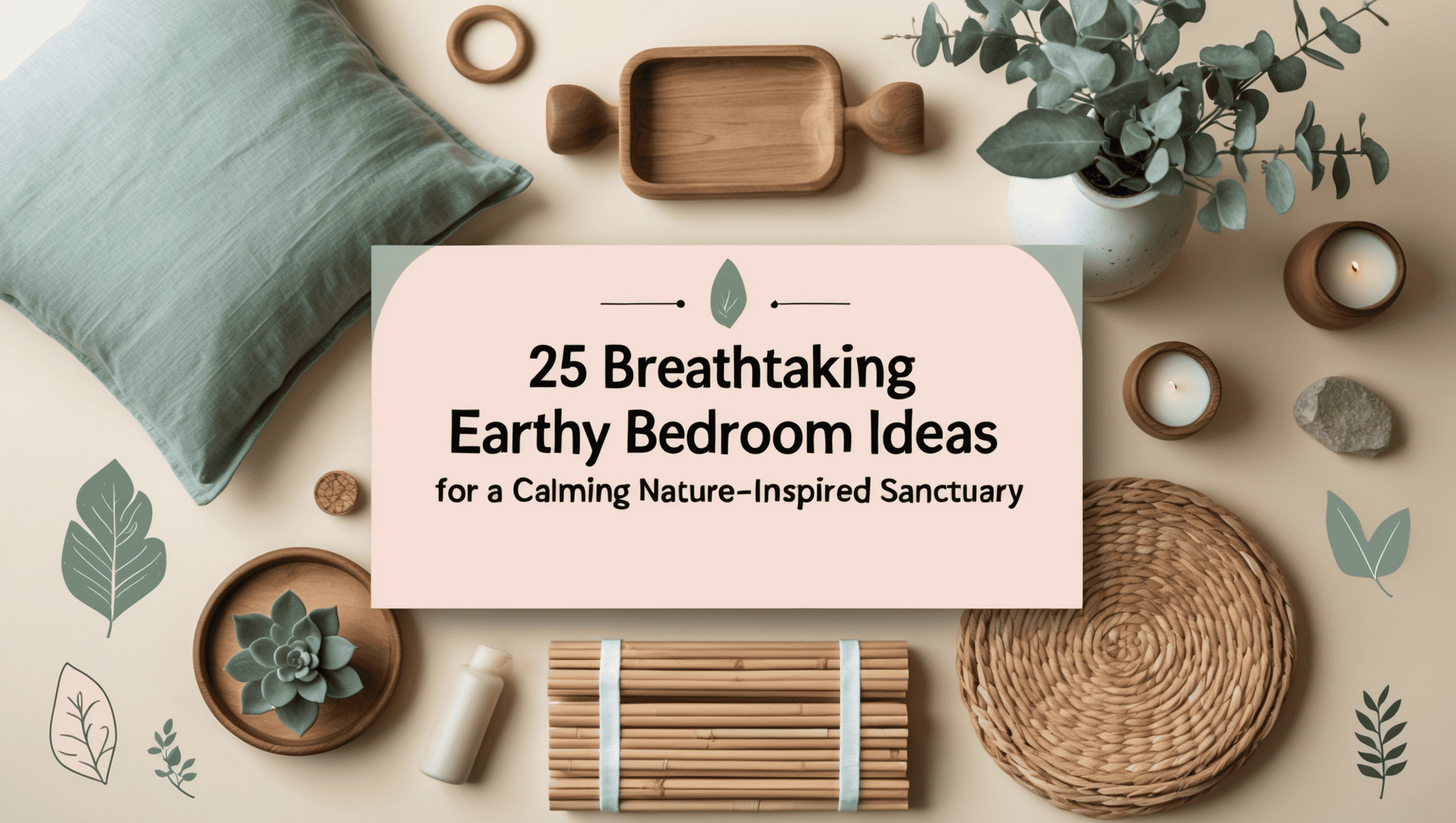
Are you craving a peaceful retreat from the hustle and bustle of daily life? Imagine walking into your bedroom and instantly feeling the stress melt away as you’re enveloped in the soothing embrace of earth-inspired colors and textures.
Earthy bedroom designs aren’t just beautiful—they’re a deliberate choice to bring the grounding, calming influence of nature into your most intimate space. The right combination of natural elements, organic textures, and earth-toned palettes can transform your bedroom from just another room into a genuine sanctuary that nurtures your well-being and promotes restful sleep.
In this article, I’m thrilled to share 25 of my absolute favorite earthy bedroom ideas that I’ve either incorporated into my own home or recommended to clients with stunning results! Each concept offers a unique approach to bringing the outdoors in, creating spaces that feel both grounded and elevated.
You’ll discover how to work with natural materials, incorporate biophilic elements, and use color psychology to create a bedroom that not only looks magazine-worthy but actually improves your quality of life.
Ready to transform your bedroom into an earthy oasis that reflects your connection to nature while providing the perfect backdrop for rest and rejuvenation? Let’s dive in!
This post may contain some affiliate links. As an Amazon Associate, I may earn from qualifying purchases at no extra cost to you. Some products may have been gifted for testing and review. That being said, I only recommend products and services I genuinely believe in. Additionally, some content on this website may have been created with the help of AI.
What You Might Need
- Natural material furniture pieces (wood, rattan, bamboo)
- Earth-toned paint or wallpaper
- Organic cotton or linen bedding
- Indoor plants of various sizes
- Natural fiber rugs (jute, sisal, wool)
- Ceramic or stone decorative items
- Woven baskets and storage solutions
- Essential oil diffuser with earthy scents
- Natural light sources and warm lighting fixtures
- Sustainable textiles for curtains and pillows
- Handcrafted décor items from natural materials
1. Minimalist Sage Green Sanctuary with Natural Wood Accents
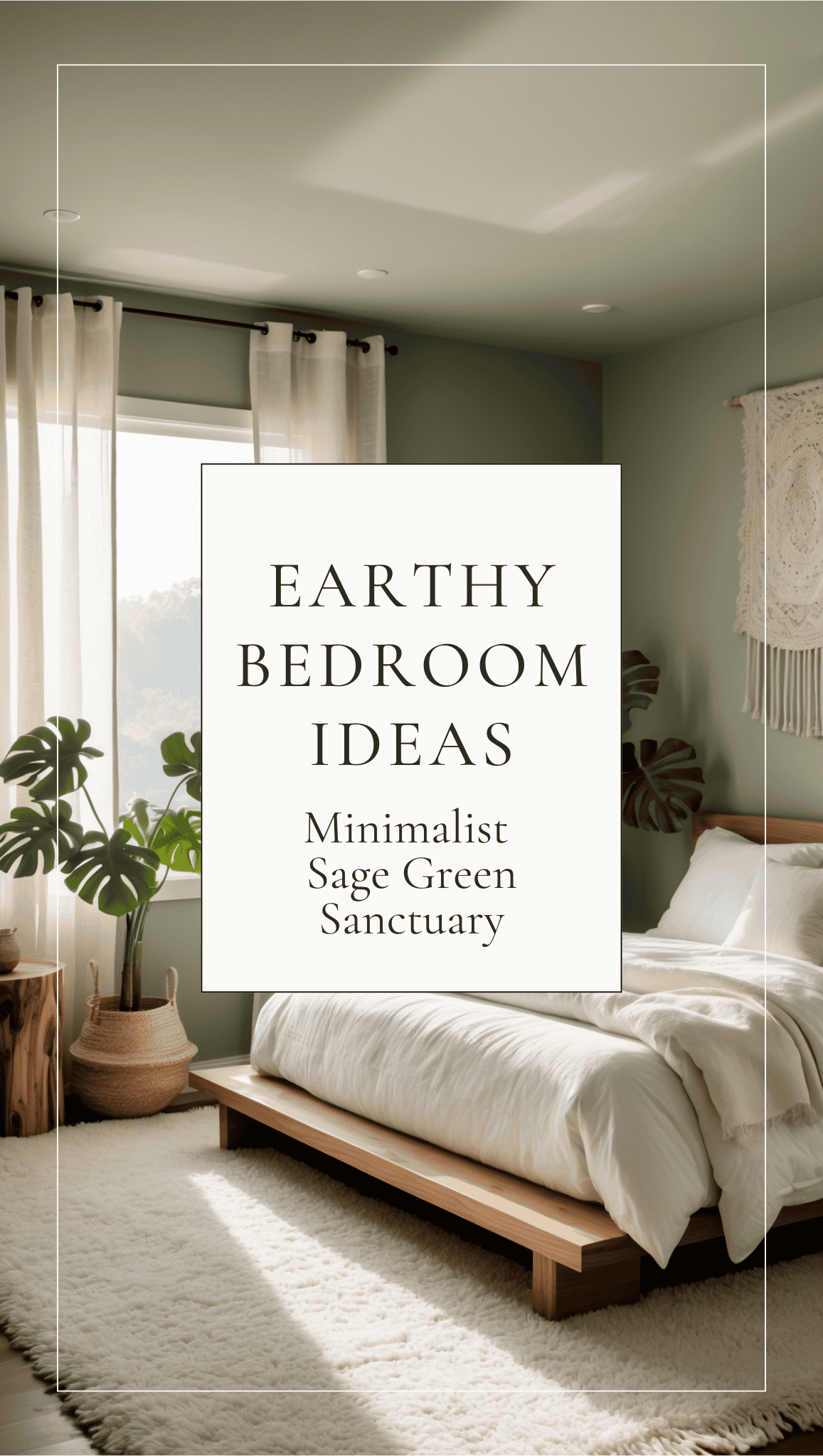
There’s something incredibly calming about stepping into a minimalist sage green bedroom that instantly transports you away from the chaos of daily life. I’ve always been drawn to the subtle power of sage green—it’s not as obvious as emerald or as expected as mint, making it the perfect choice for a nature-inspired space without overwhelming color.
When I redesigned my guest bedroom last year, I chose a matte sage green for the walls, and the transformation was nothing short of magical. The flat finish absorbs light rather than reflecting it, creating a soft, diffused glow that makes the space feel like it’s giving you a gentle hug at the end of a long day.
Benefits of Sage Green Tones
The color sage green has been shown to reduce anxiety and promote restful sleep due to its connection to nature.
Enhancing Visual Space
Matte finishes absorb light rather than reflect it, creating a more spacious feeling and hiding wall imperfections.
Pairing Green with Natural Wood
The combination of sage green and warm wood tones creates a perfect balance between cool and warm elements for a harmonious feeling.
How to Create This Look
- Choose a premium matte paint in sage green with a gray undertone for sophistication
- Select furniture with clean lines and natural wood finishes (oak, walnut, or maple)
- Incorporate white bedding with minimal texture for a crisp contrast
- Add 1-2 statement plants like a fiddle leaf fig or snake plant
- Install warm-toned LED lighting rather than cool white bulbs
- Include no more than 3-5 decorative objects total to maintain the minimalist aesthetic
Picture This
Imagine walking into your bedroom after a hectic day and being enveloped by the gentle embrace of sage green surfaces. The afternoon sun filters through sheer linen curtains, casting a soft glow on your oak platform bed. The matte finish makes the room feel expansive yet cozy, while carefully selected furniture creates intentional minimalism. A single monstera plant stretches toward the light, creating organic shadows across the floor. This sanctuary doesn’t just look beautiful—it feels like the visual equivalent of a deep, cleansing breath.
2. Vintage Glam Bedroom with Gold-Trimmed Furniture
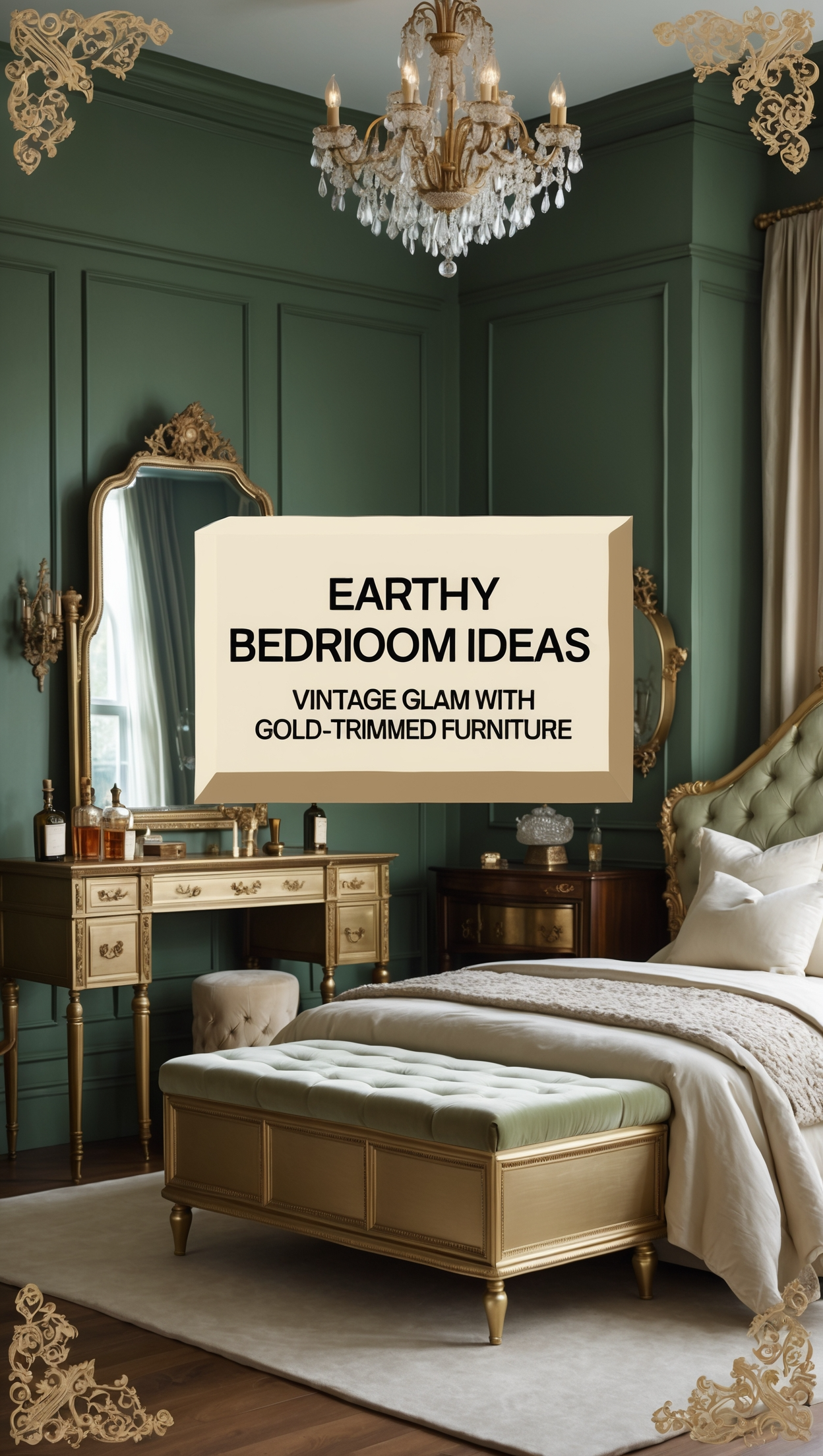
I adore the unexpected magic that happens when you pair the earthiness of sage green with the opulence of vintage glamour elements. This combination creates a fascinating tension between understated and statement, between natural and luxurious.
The first time I experimented with this look was for a friend who inherited her grandmother’s ornate gold-trimmed vanity but wanted a contemporary space. We painted her walls in a rich sage green with subtle gray undertones, and suddenly that heirloom piece became a magnificent focal point against the nature-inspired backdrop.
Benefits of Vintage Elements
Incorporating vintage pieces adds character, history, and uniqueness to your space that cannot be replicated with mass-produced items.
Enhancing Traditional Architecture
Sage green complements traditional architectural features like crown molding and wainscoting, highlighting their craftsmanship.
Pairing Sage with Metallics
Gold and brass accents create striking visual contrast against sage green, bringing warmth and sophistication to the space.
Steps to Achieve This Look
- Start with a sage green paint with slightly more gray undertones for a sophisticated backdrop
- Incorporate a statement vintage piece like a vanity, headboard, or dresser with ornate details
- Add gold-framed mirrors or artwork to create reflection and visual interest
- Choose luxurious bedding with subtle texture or pattern in cream or champagne tones
- Install vintage-inspired lighting fixtures with brass or gold finishes
- Include velvet accent pillows or a throw in complementary jewel tones like amethyst or sapphire
- Display vintage perfume bottles or decorative boxes on surfaces for authentic character

Picture This
As you enter this vintage glam bedroom, sage green surrounds you with refined elegance and a natural connection. A brass chandelier casts warm light across the room, dancing off the gold details of an ornate mirror above an antique vanity. The tufted velvet headboard anchors the space, adorned with textured pillows inviting you to sink in. Vintage books and brass trinkets add character to nightstands, while sheer curtains billow at windows framed in original woodwork. This room doesn’t merely showcase beautiful things—it tells a story of treasured heirlooms against that perfect sage green canvas.
3. Zen-Inspired Retreat with Bamboo Decor Elements
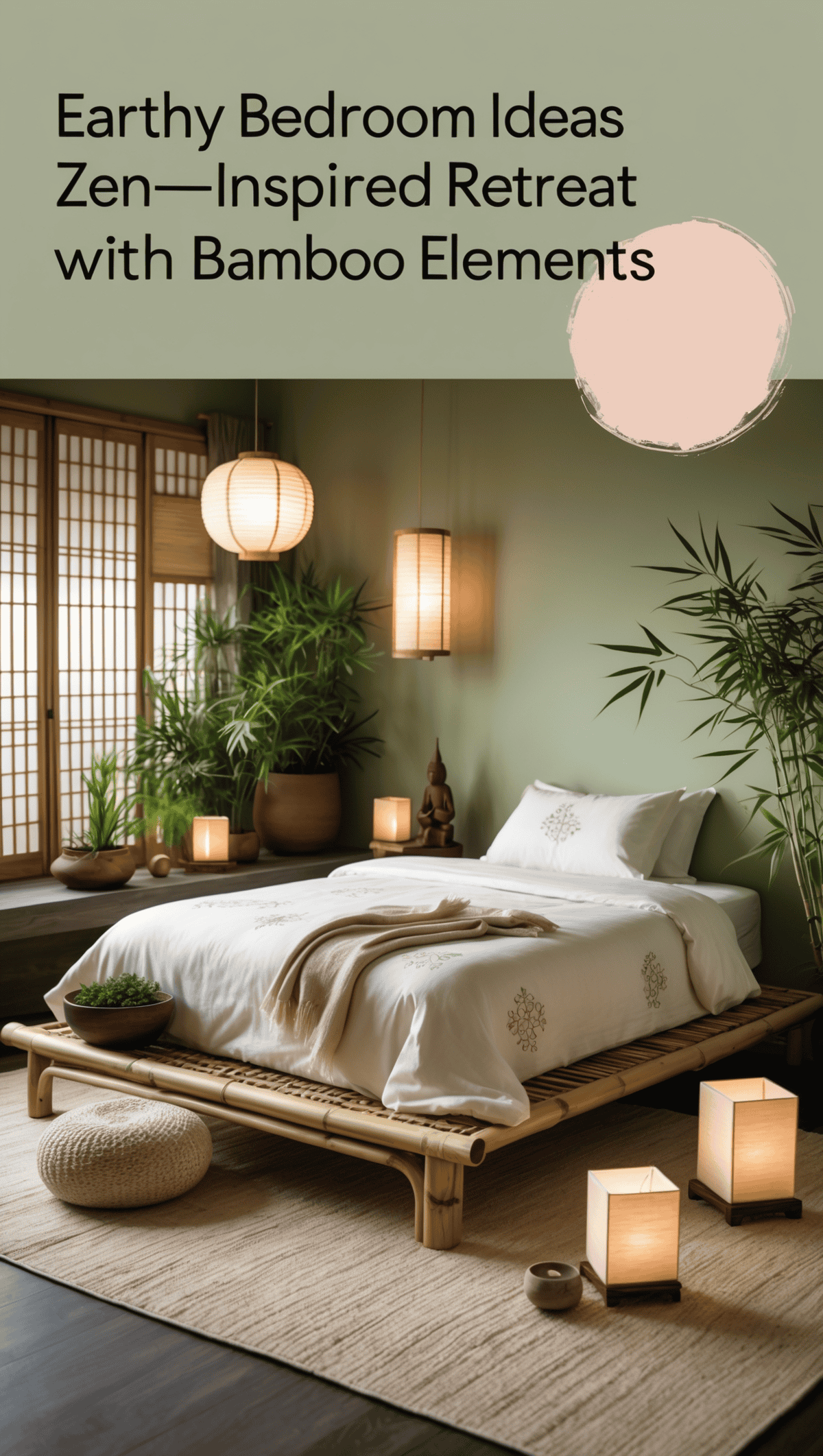
A truly zen-inspired bedroom invokes a profound sense of peace, and incorporating sage green creates an immediate connection to the natural world. This design draws inspiration from the balance of simplicity and natural elements often seen in traditional Japanese spaces, where every element serves both a functional and aesthetic purpose.
What I appreciate most about zen-inspired bedrooms is their deliberate removal of excess, ensuring each item contributes to a tranquil environment.
Benefits of Zen Design
Zen-inspired spaces promote mental clarity, reduce visual distractions, and create an environment conducive to mindfulness and quality sleep.
Enhancing Mindful Living
The combination of sage green and minimalist design helps create a space that encourages presence and conscious living.
Pairing Sage with Bamboo
Bamboo’s natural color and texture creates authentic Asian-inspired design elements that complement sage green’s earthy quality.
How to Recreate It
- Paint walls in a sage green with yellow undertones to create warmth and reference bamboo
- Choose a low platform bed with clean lines and minimal ornamentation
- Incorporate bamboo elements through furniture, window treatments, or decorative accents
- Create a small meditation corner with a floor cushion and low table
- Add 1-3 potted bamboo plants or simple bonsai trees
- Use natural linen bedding in neutral tones like oatmeal or soft white
- Include a small tabletop fountain for the subtle sound of flowing water
- Install soft, diffused lighting with paper lanterns or simple rice paper shades

Picture This
As you slide open the door to your zen-inspired bedroom, the sage green surfaces exhale tranquility, reminiscent of a serene bamboo forest after rain. The low platform bed sits in perfect symmetry, adorned only with crisp linen bedding. A single orchid blooms on the windowsill, while a small fountain creates a gentle soundtrack of flowing water. Rice paper lanterns cast diffused golden light as evening approaches, highlighting the intentional negative space. This isn’t just a bedroom; it’s a sanctuary where sage and bamboo elements create a retreat from modern chaos.
4. Mid-Century Modern Bedroom with Walnut Furnishings

I’ve always been fascinated by how mid-century modern design manages to feel simultaneously vintage and timeless. Adding sage green textiles to this aesthetic creates a wonderful organic dimension! When helping my cousin redesign her bedroom, she was torn between her love of clean mid-century lines and her desire for a nature-connected space.
Introducing sage green through textiles rather than walls became our perfect solution—it allowed the walnut furniture to remain the star while softening the sometimes austere feel of mid-century design.
Benefits of Mid-Century Design
The clean lines and functional beauty of mid-century modern furniture create a calming environment free from visual clutter while maintaining warmth.
Enhancing Natural Wood Elements
Walnut and teak furniture pieces pop dramatically against sage green textiles, highlighting the gorgeous grain patterns of these classic woods.
Pairing Sage with Geometric Patterns
Mid-century geometric patterns in sage green create visual interest while maintaining an earthy, grounded feeling throughout the space.
How to Style It
- Start with signature mid-century walnut furniture pieces with tapered legs and clean lines
- Layer in sage green through duvet covers, throw pillows, and a statement area rug
- Add a textural element with a woven wall hanging in complementary earth tones
- Incorporate 1-2 authentic or reproduction mid-century table lamps with linen shades
- Display a curated collection of vintage ceramics in sage and complementary terracotta
- Install floating walnut shelves for displaying plants and mid-century accessories
- Add a statement chair in sage green textured fabric to complete the look

Picture This
In this mid-century modern haven, warm walnut furniture with distinctive tapered legs provides the perfect foundation for layers of sage green textiles. A low-profile platform bed topped with sage linen bedding creates a serene focal point, while a geometric area rug anchors the space with subtle pattern. Brass accents catch the light from sculptural table lamps, creating warm reflections across the room. A single Eames chair in sage bouclé fabric sits in the corner beneath a fiddle leaf fig, offering the perfect reading nook. The sage textiles soften the room’s architectural lines while honoring the mid-century ethos of bringing the outdoors in.
5. Bohemian Hideaway with Macramé Wall Hangings
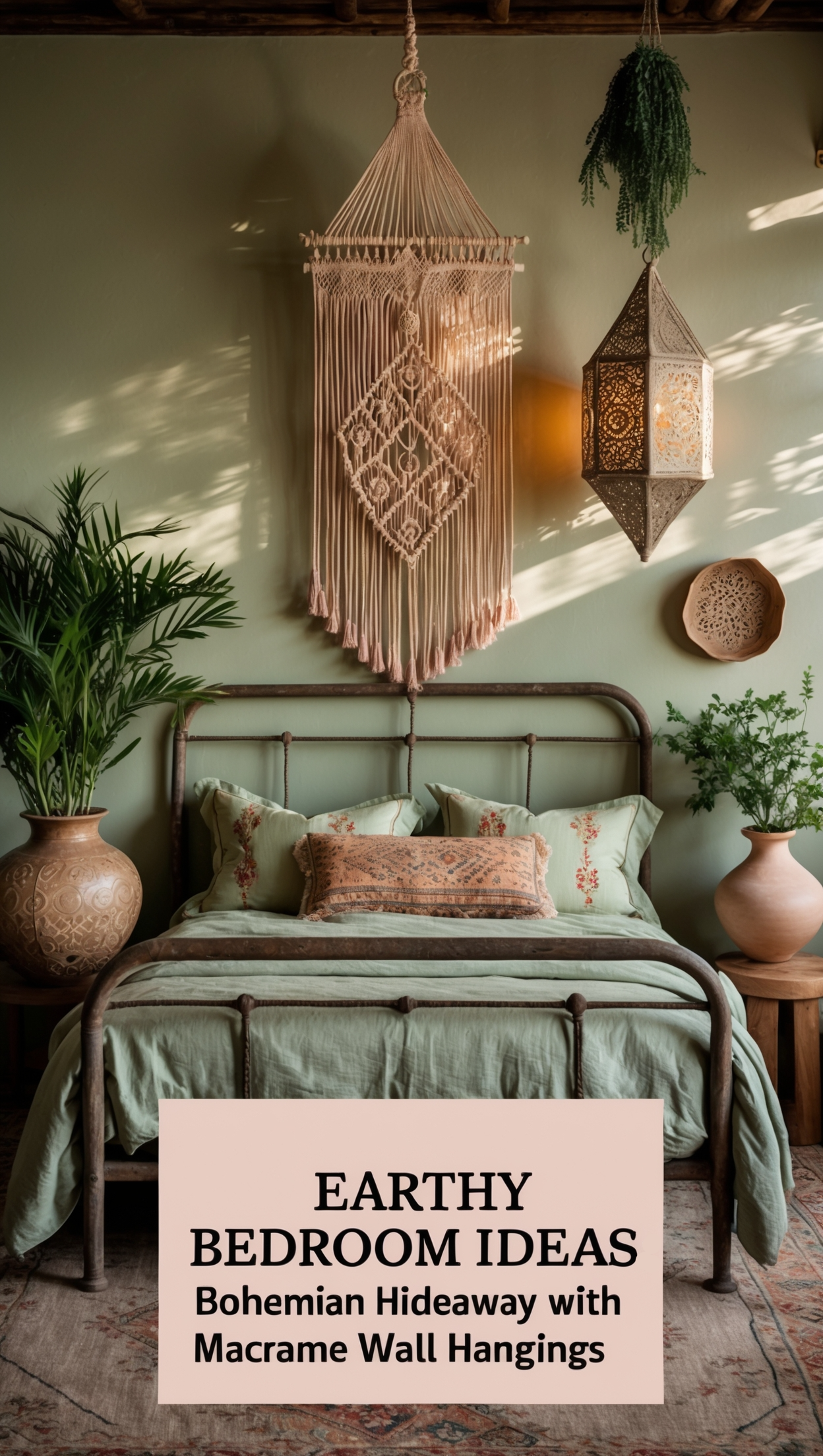
There’s something magical about eclectic bohemian spaces that makes them feel simultaneously collected and curated, personal and universal. When I incorporated sage green bedding into my own boho bedroom last summer, it instantly became the perfect neutral foundation for my global-inspired treasures.
What I love about this combination is how the muted sage green acts as a visual resting place amidst the beautiful chaos of patterns, textures, and meaningful objects that make bohemian spaces feel so alive with stories and memories.
Benefits of Bohemian Style
Bohemian design encourages personal expression through collected treasures, creating a space that tells your unique story while feeling warm and lived-in.
Enhancing Cultural Elements
Sage green complements global textiles and artifacts beautifully, allowing their colors and patterns to stand out while remaining cohesive.
Pairing Sage with Macramé
The natural cotton of macramé wall hangings creates beautiful textural contrast against sage green bedding, reinforcing the handcrafted aesthetic.
How to Create This Look
- Begin with sage green bedding as your foundation—ideally linen or cotton with subtle texture
- Layer multiple pillows in complementary earth tones with various global patterns
- Hang a statement macramé piece above the bed or in a visible corner
- Mix different wood tones through furniture pieces with history and character
- Add low, ambient lighting through Moroccan-inspired lanterns or salt lamps
- Incorporate natural elements like dried pampas grass or preserved eucalyptus
- Display treasured objects from travels or meaningful gifts on open shelving
- Include at least one vintage rug with faded colors that complement sage green

Picture This
In this bohemian sanctuary, sage green linen bedding drapes casually across a vintage iron bed frame, creating a serene foundation for an array of globally-inspired throw pillows. A substantial macramé wall hanging creates dramatic texture above the headboard, its natural cotton fibers catching the golden light from a Moroccan pierced metal pendant. Plants in various handmade ceramic pots bring life to every corner, while a faded vintage rug ties the eclectic elements together. The sage bedding doesn’t compete with the room’s treasures—instead, it enhances them, allowing each piece to tell its story against this tranquil green backdrop.
6. Art Deco Haven with Geometric Patterns

The bold glamour of Art Deco design paired with the subtle earthiness of sage green creates an unexpected but absolutely stunning bedroom aesthetic! I first fell in love with this combination at a boutique hotel in San Diego, where the sage green velvet headboard became the perfect contemporary twist on classic Art Deco style.
What makes this pairing work so beautifully is the contrast between the organic, natural quality of sage green and the precise, geometric patterns characteristic of Art Deco design. The velvet texture adds another layer of luxury that honors the opulence of the era while feeling fresh and current.
Benefits of Art Deco Elements
Art Deco’s bold geometric patterns and symmetry create a sense of order and intention that promotes restful sleep and a feeling of luxury.
Enhancing Architectural Details
Sage green velvet softens the sometimes harsh lines of Art Deco while highlighting architectural details like stepped moldings or sunburst patterns.
Pairing Sage with Metallics
The combination of sage green with Art Deco’s characteristic metallic accents creates a perfect balance between earthy and glamorous elements.
Steps to Achieve It
- Invest in a statement sage green velvet headboard with classic Art Deco lines or curves
- Incorporate geometric patterns through wallpaper, textiles, or artwork
- Add metallic accents in brass or chrome through lighting fixtures and decorative objects
- Include mirrored surfaces through nightstands, dressers, or wall mirrors
- Choose bedding in complementary neutrals like cream, taupe, or soft gold
- Install sconces or table lamps with frosted glass shades for authentic period lighting
- Add 1-2 plants with architectural shapes like snake plants or rubber trees
- Display vintage or reproduction Art Deco accessories to complete the look

Picture This
Stepping into this Art Deco haven feels like entering a modern speakeasy retreat. The sage green velvet headboard commands attention with its dramatic curved silhouette, while geometric patterns play across custom pillows and a period-inspired area rug. Brass sconces with frosted glass globes flank the bed, casting a warm glow against walls painted in a complementary neutral. A sleek mirrored dresser reflects light around the room, topped with vintage perfume bottles and a sculptural plant. The sage velvet softens the room’s bold lines and metallic accents, creating a space that feels both indulgent and grounded.
7. Coastal Oasis with Driftwood Accessories
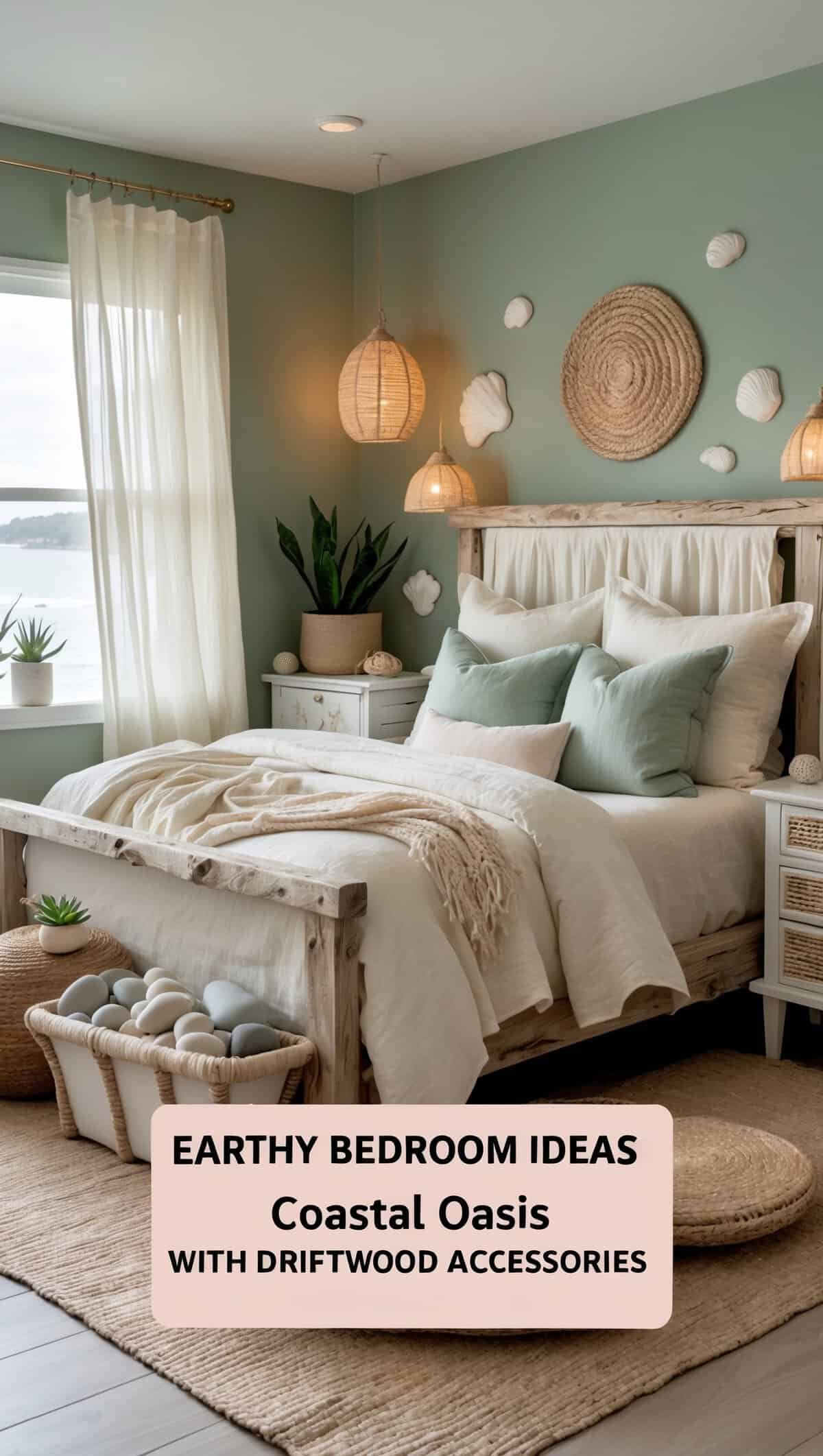
There’s something eternally appealing about coastal bedrooms that transport you to the serene meeting point of land and sea. When my friend and I redesigned her beach cottage bedroom, replacing the expected blue palette with sage green created a sophisticated coastal retreat that avoided typical nautical clichés.
What I love about this combination is how sage green references the subtle tones of coastal sage scrub and sea glass, creating a more nuanced connection to shoreline ecosystems than traditional maritime colors. The color has a wonderful way of shifting throughout the day, much like the ocean itself.
Benefits of Coastal Elements
Natural coastal elements like driftwood and shells connect you to the restorative power of shoreline environments, promoting relaxation and peaceful sleep.
Enhancing Natural Light
Sage green surfaces beautifully reflect and soften natural light, creating the airy, open feeling essential to coastal design.
Pairing Sage with Driftwood
The silvery gray tones of weathered driftwood create perfect harmony with sage green, reinforcing the organic, weathered aesthetic of coastal design.
How to Style It
- Paint walls in a sage green with blue undertones to reference sea glass and coastal vegetation
- Incorporate weathered wood through bed frames, dressers, or decorative pieces
- Add textural elements through natural fiber rugs, linen curtains, and cotton bedding
- Display a curated collection of sea glass, shells, or smooth stones in glass vessels
- Install sheer window treatments that allow maximum natural light
- Choose artwork depicting subtle coastal scenes or abstracts in complementary colors
- Include rattan or wicker accent pieces for additional natural texture
- Add potted succulents or air plants that thrive in coastal environments
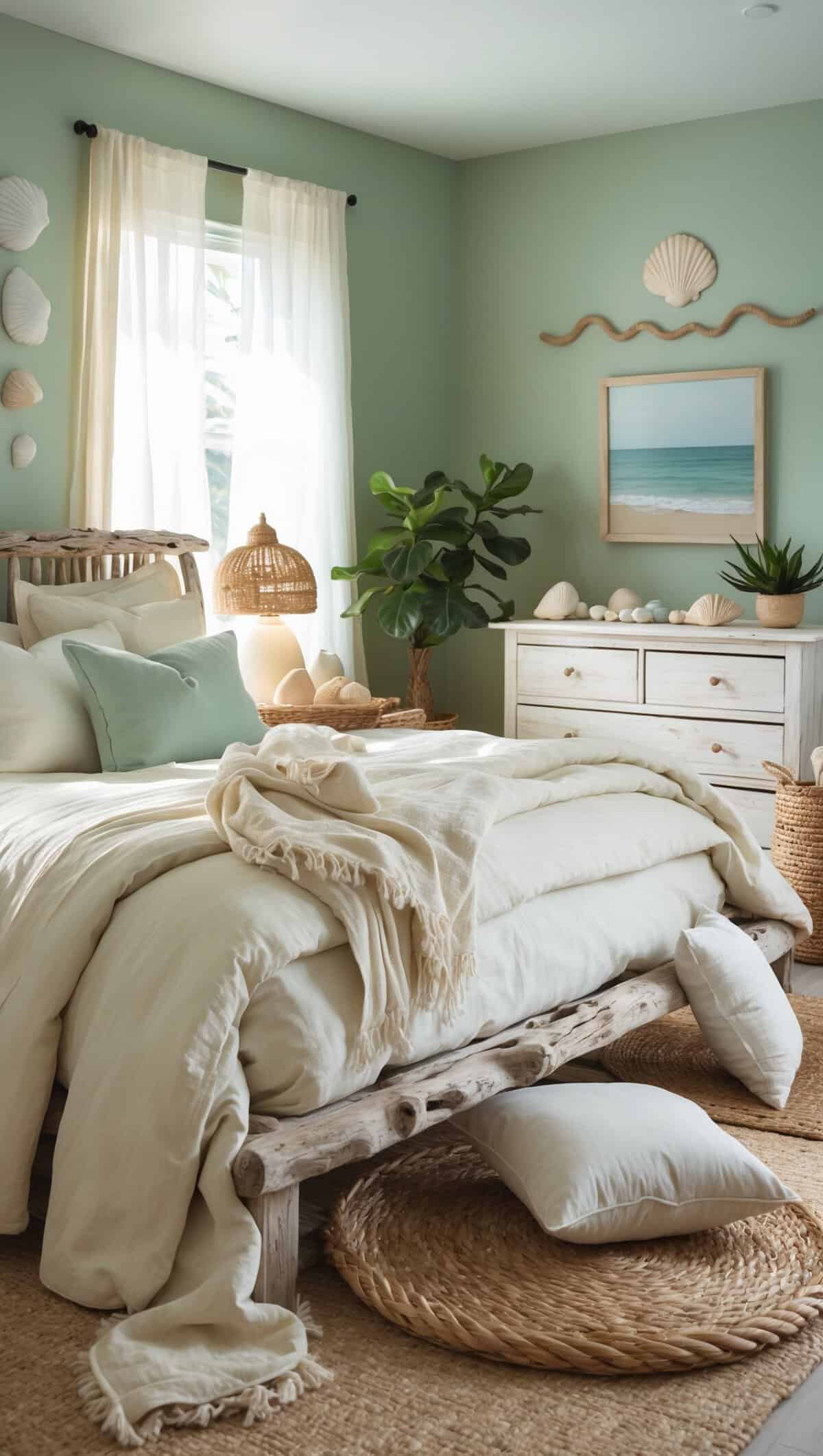
Picture This
In this coastal sanctuary, surfaces the color of sea glass create a serene backdrop for a bed crafted from weathered driftwood. Sunlight streams through gauzy white curtains that gently billow with the breeze, casting ever-changing shadows across natural jute rugs. A carefully edited collection of smooth stones and sea glass catches the light on a simple whitewashed dresser. The sage green shifts subtly throughout the day, sometimes more blue, sometimes more gray—much like the ocean visible through the windows. This space doesn’t rely on obvious coastal motifs; instead, it captures the essence of shoreline tranquility.
8. Industrial Chic Space with Distressed Metal Detailing
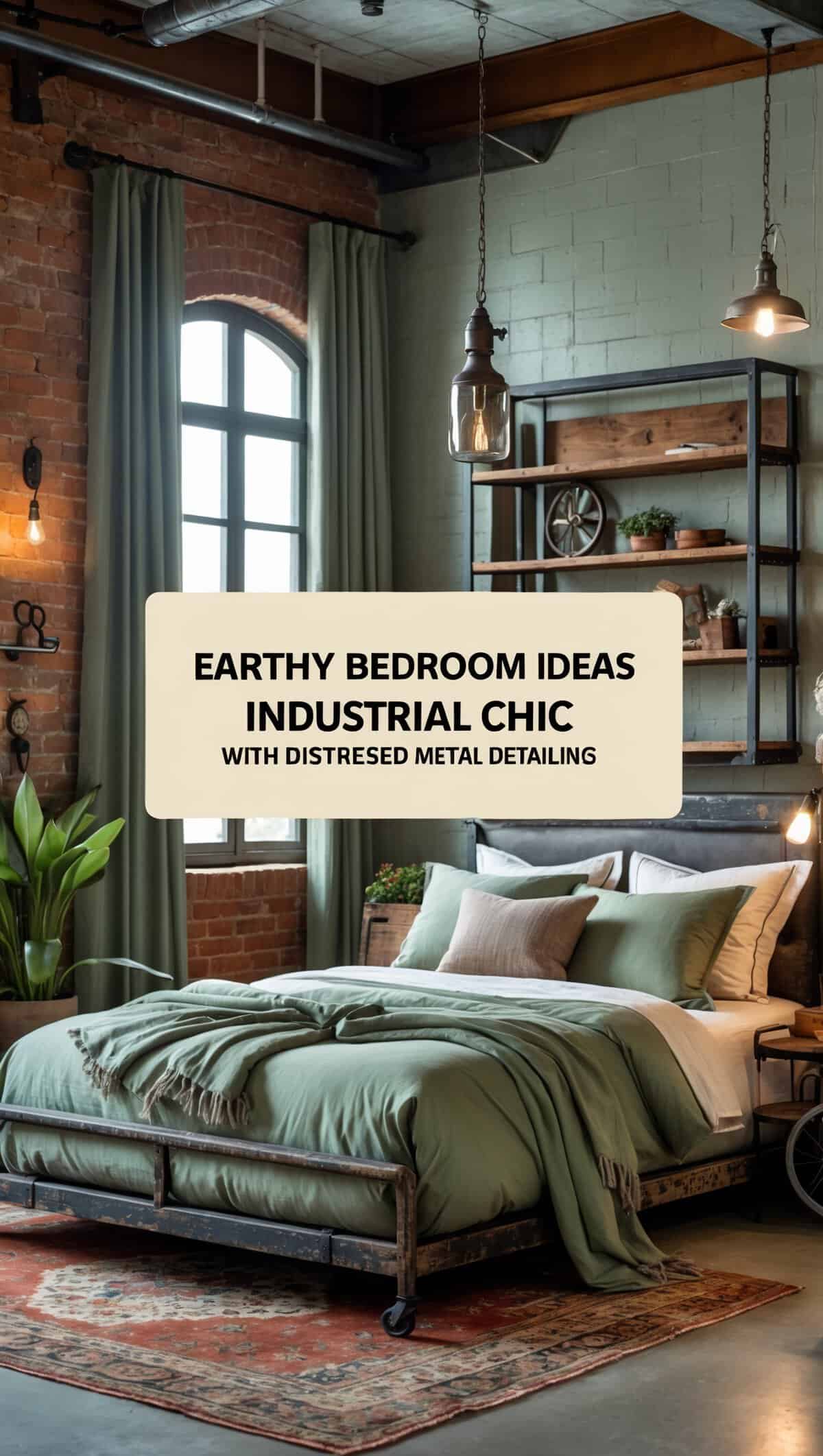
When I first suggested combining industrial design elements with sage green accents to a client living in a converted warehouse loft, she was skeptical. But the moment we installed the sage green linen curtains against he exposed brick and added sage green throw pillows to her leather sofa, the magic happened.
What makes this combination work so beautifully is how the soft, organic quality of sage green softens the sometimes harsh or cold feeling of industrial spaces, creating a perfect balance between raw and refined, masculine and organic.
Benefits of Industrial Elements
Industrial design features like exposed brick, concrete, and metal create character and architectural interest while honoring the history of the space.
Enhancing Urban Spaces
Sage green accents soften the hardness of industrial materials, creating visual contrast and warmth in urban environments.
Pairing Sage with Distressed Metal
The patina of distressed metal complements the muted quality of sage green, both elements sharing a weathered, timeless quality.
How to Achieve This Look
- Keep walls in their natural state (exposed brick, concrete) or paint one accent wall in sage green
- Incorporate distressed metal through bed frames, shelving units, or decorative objects
- Add warmth through sage green textiles—bedding, curtains, throw pillows, or an area rug
- Include utilitarian lighting fixtures in black metal or antiqued brass
- Mix in reclaimed wood elements through headboards, side tables, or floating shelves
- Use storage solutions that embrace industrial style like metal rolling carts or pipe shelving
- Add 2-3 low-maintenance plants like succulents in concrete or metal planters
- Display vintage industrial objects like gears, old tools, or factory molds as art pieces
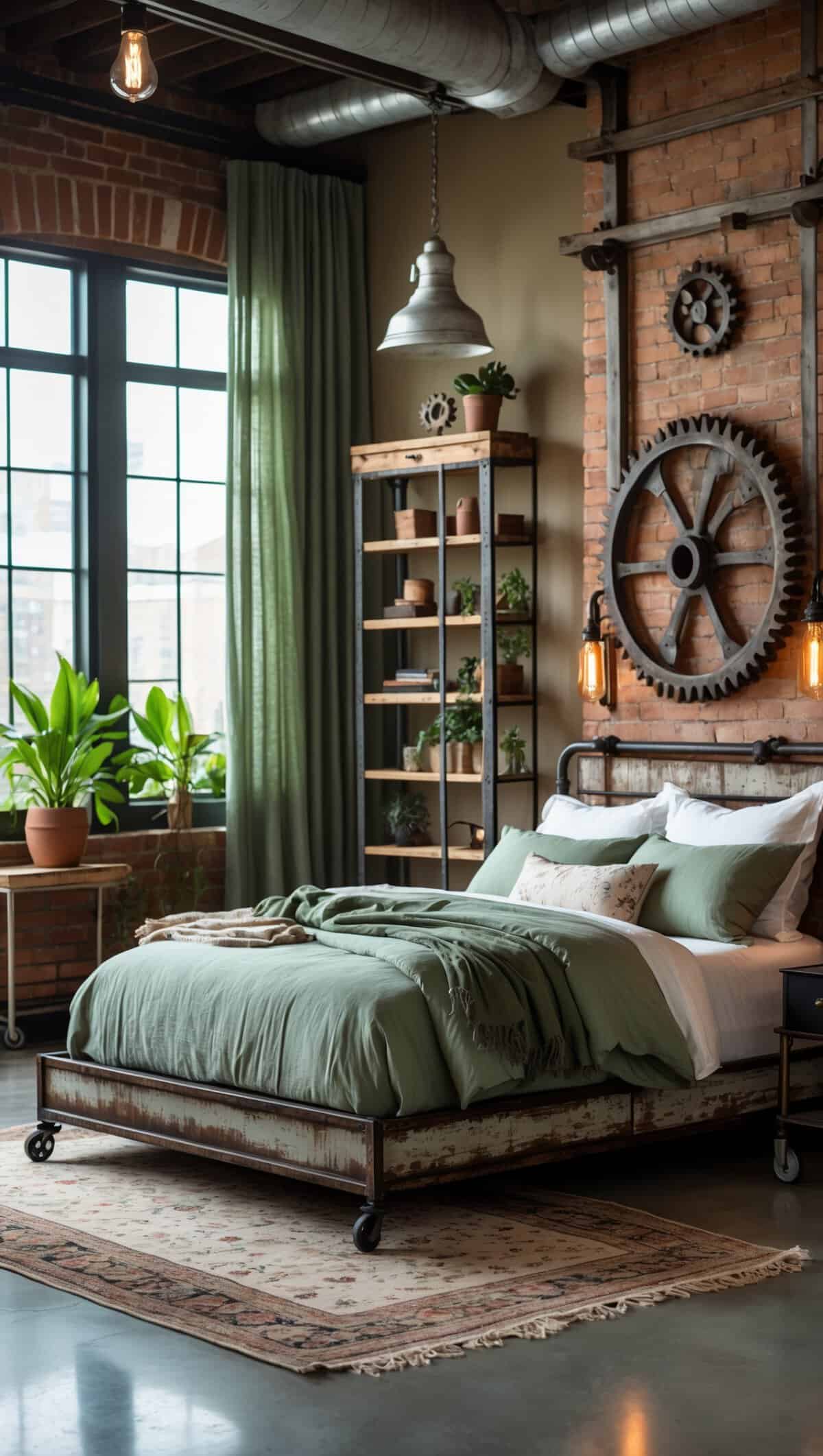
Picture This
This industrial haven balances raw structural elements with the soothing presence of sage green textiles. A platform bed with a distressed metal frame anchors the space, topped with luxuriously simple sage linen bedding. Exposed brick walls and concrete floors provide authentic industrial character, while vintage factory pendants cast pools of warm light across the space. A rolling metal cart serves as a nightstand, displaying an eclectic mix of hardcover books and industrial artifacts. The sage green accents don’t fight the industrial elements—instead, they soften and elevate them, creating a space that feels both urban and organic.
9. Scandinavian-Inspired Room with Light Oak Floors
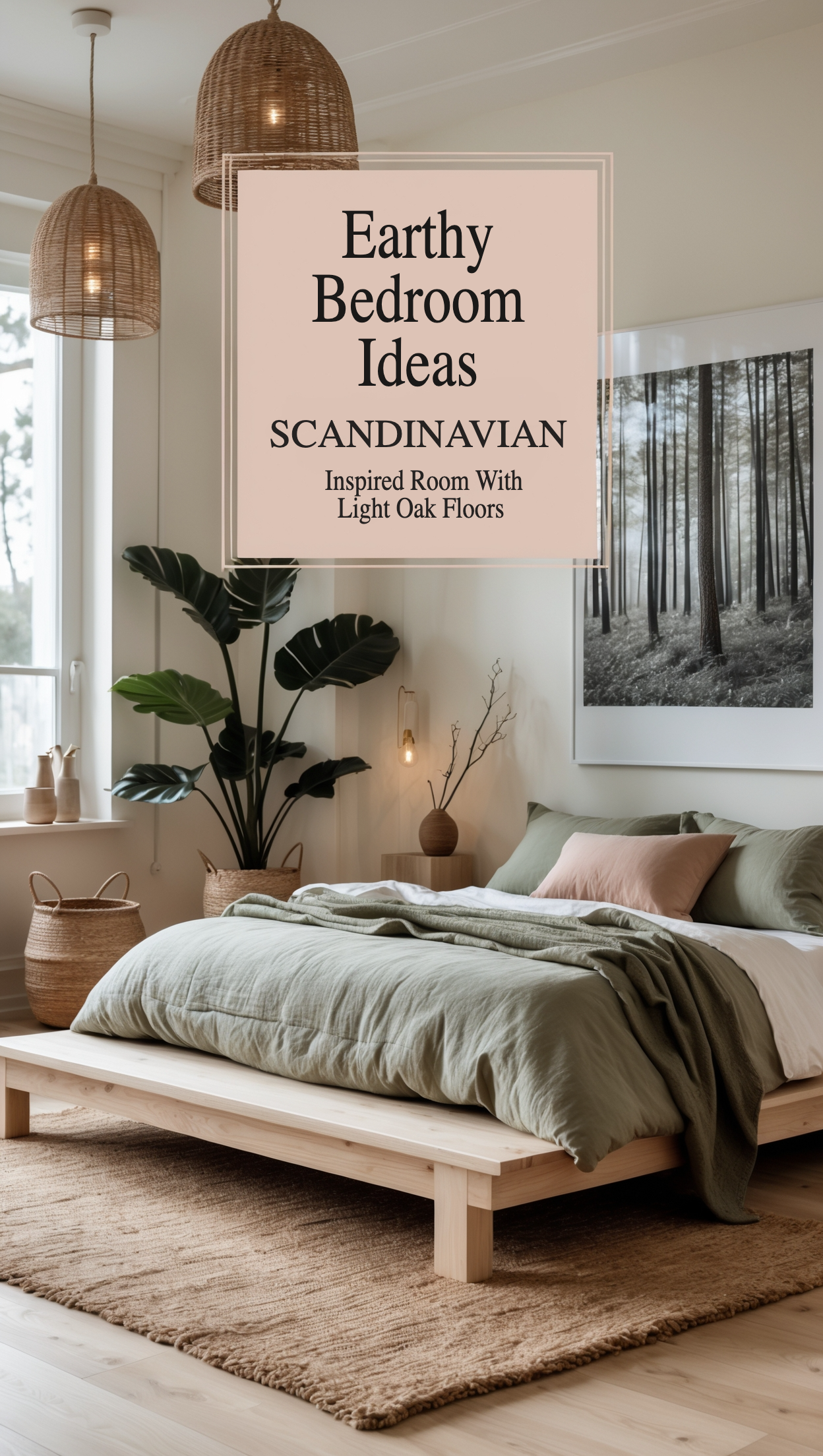
The timeless elegance of Scandinavian design paired with sage green linens creates an appealing bedroom combination. This design approach draws on the effortless way the Swedes incorporate nature into their interiors, a philosophy that can be seamlessly integrated into your design projects.
What stands out about this pairing is how sage green serves as an ideal “new neutral” in a Scandinavian space, subtly adding color while maintaining the clean and light aesthetic that makes Nordic design so inviting and restful.
Benefits of Scandinavian Design
Scandinavian interiors prioritize simplicity, functionality, and connection to nature, creating spaces that feel both practical and peaceful.
Enhancing Light and Space
Light oak floors reflect natural light, working with sage green accents to create the bright, airy feeling essential to Scandinavian design.
Pairing Sage with Blonde Woods
The warm honey tones of light oak create beautiful harmony with sage green, both colors referencing the natural world in complementary ways.
How to Style It
- Keep walls white or very light gray to maximize natural light reflection
- Install light oak flooring or incorporate blonde wood through furniture pieces
- Add sage green through bedding, throw pillows, and small decorative objects
- Include practical storage solutions with clean lines and minimal hardware
- Incorporate hygge elements like chunky knit throws, sheepskin rugs, or woven textiles
- Maximize natural light with minimal window treatments in light, natural materials
- Add 1-2 statement houseplants like a fiddle leaf fig or rubber plant
- Display simple artwork featuring nature motifs or abstract landscapes in complementary tones

Picture This
In this Scandinavian-inspired bedroom, morning light streams across light oak floors, creating a warm glow that complements the sage green linen duvet. A simple platform bed crafted from blonde wood anchors the space without overwhelming it, while woven pendant lights hang at different heights beside it. A sheepskin rug adds textural contrast against the smooth wood floor, inviting bare feet on chilly mornings. A single black and white photograph of a forest scene creates a focal point against white walls. This space embodies the Swedish concept of lagom—not too much, not too little, but just right.
10. Urban Jungle Retreat with Abundant Indoor Plants
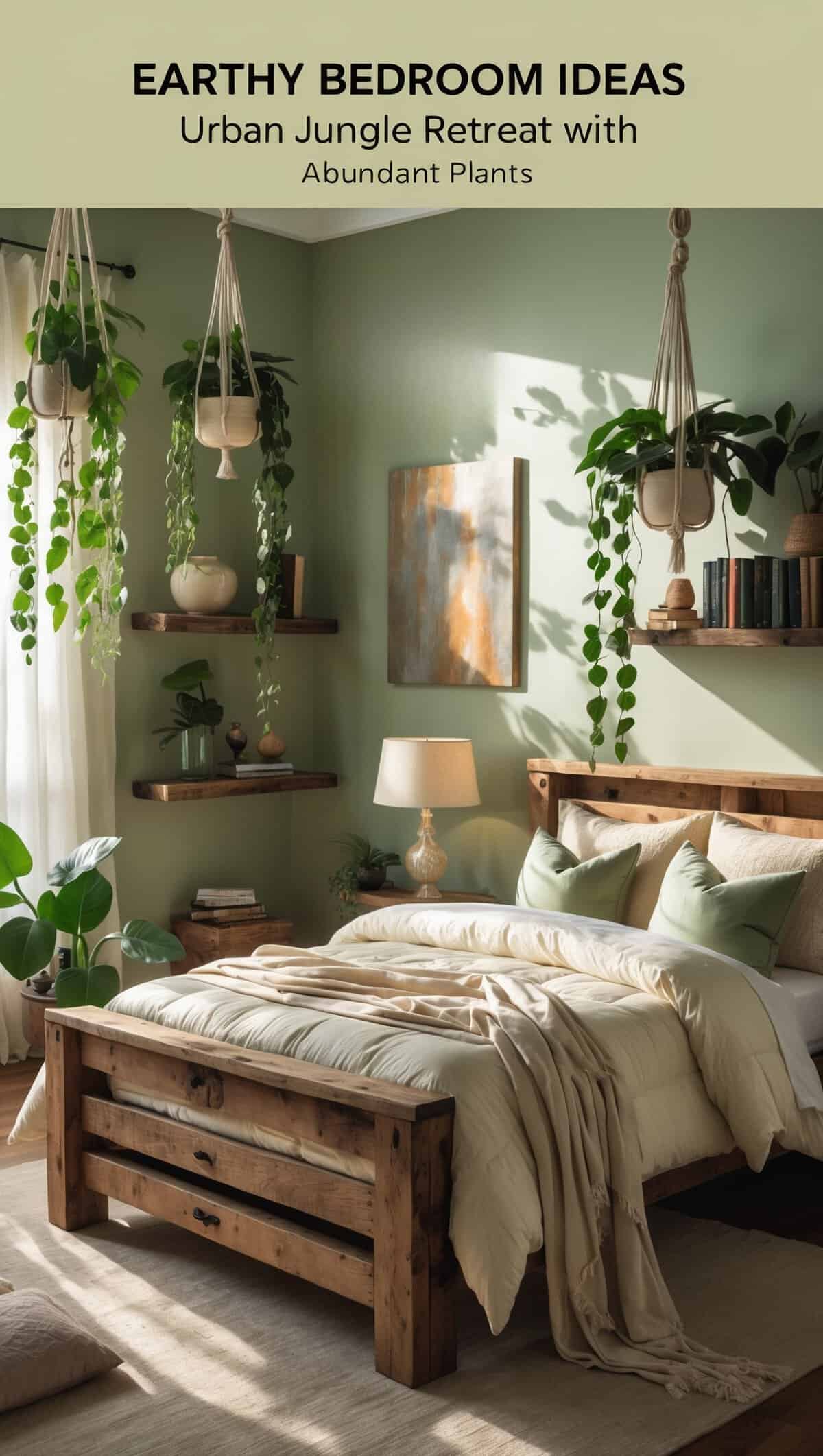
I discovered my passion for plant-filled spaces when I transformed my city apartment bedroom into a lush urban jungle years ago. Painting the walls a soft sage green created the perfect backdrop for my growing plant collection, making the greenery pop while maintaining a cohesive, intentional look.
What I love about this combination is how the sage green background visually expands the plant elements throughout the room, creating the illusion of being completely surrounded by nature even in the middle of a concrete cityscape. The resulting space feels like a physical manifestation of a deep exhale—immediately calming and alive with natural energy.
Benefits of Indoor Plants
Beyond their beauty, indoor plants improve air quality, increase humidity, reduce stress, and create a vital connection to the natural world in urban environments.
Enhancing Oxygen Flow
A bedroom filled with plants creates a naturally higher oxygen environment, potentially improving sleep quality and overall wellbeing.
Pairing Sage with Plant Varieties
Sage green backgrounds make plant foliage pop, highlighting the various shades of green and creating a cohesive yet dynamic visual effect.
Steps to Create This Look
- Paint walls in a soft sage green to create a cohesive backdrop for plants
- Include a variety of plant types—trailing, upright, sculptural—for visual interest
- Vary planter heights using plant stands, hanging planters, and tall specimens
- Group plants with similar care needs together for practical maintenance
- Add proper lighting with full-spectrum grow lights for plants in darker corners
- Incorporate natural materials like wood, rattan, and ceramic in planter choices
- Select a comfortable bed with simple lines that won’t compete with the plants
- Include practical elements like a watering can and plant care tools as decorative objects

Picture This
In this verdant sanctuary, sage green walls create the perfect canvas for a symphony of plant life. A simple wood bed is almost hidden beneath cascading pothos vines that spill from macramé hangers above. Tall fiddle leaf figs stand sentinel in corners, while collections of smaller plants cluster on floating shelves and windowsills. Morning light filters through the leaves, creating dancing patterns across linen bedding in complementary earth tones. The air feels noticeably fresher, filled with the subtle fragrance of soil and green growth. This isn’t just decoration—it’s a living ecosystem that happens to be a stunning bedroom.
11. French Country Bedroom with Whitewashed Furniture
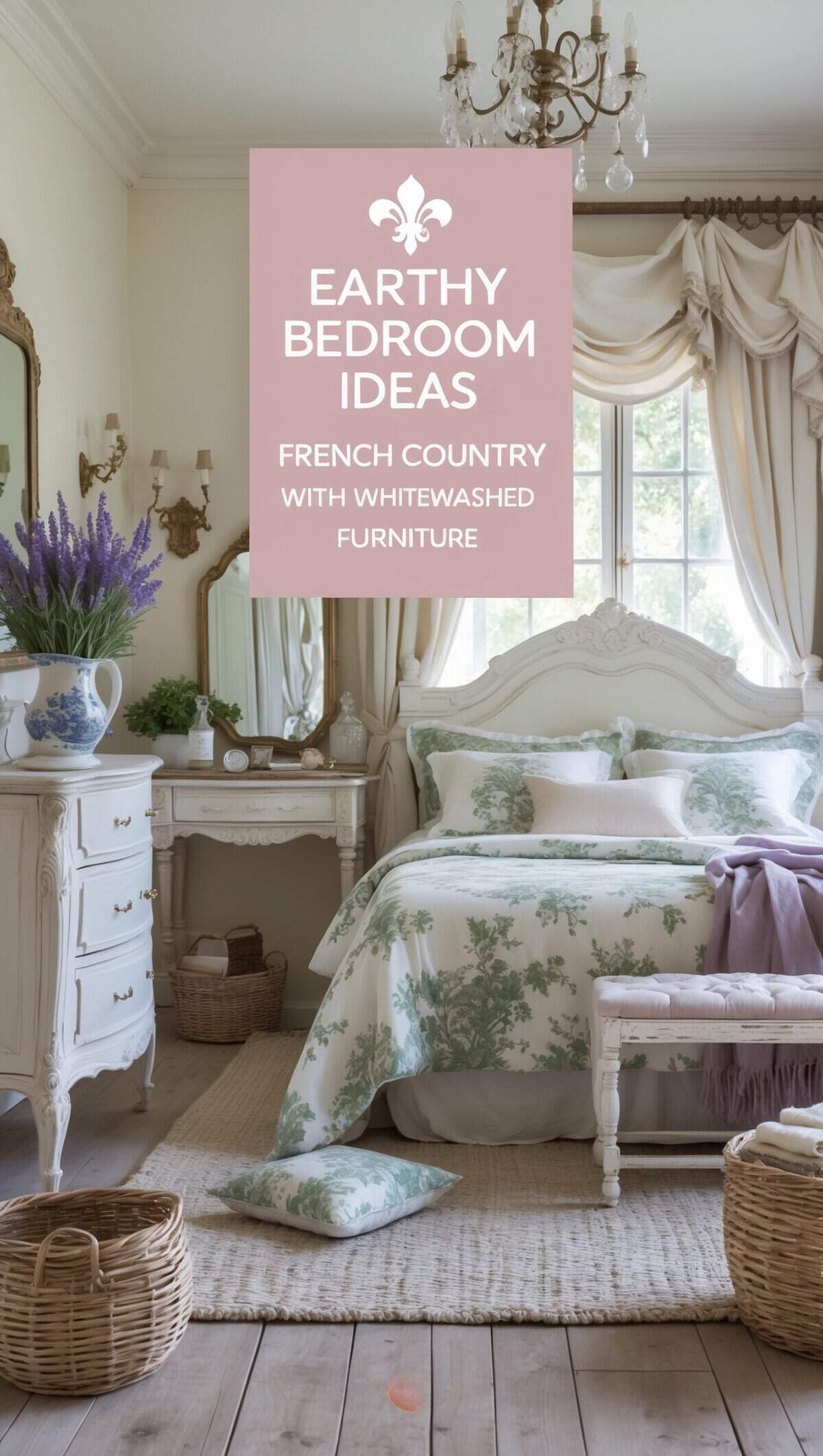
There’s an inherent warmth and welcome in French country design that has always captivated me, and discovering how beautifully sage green toile fabrics complement whitewashed furniture was a design epiphany! When helping a friend renovate her country home, we replaced the expected blue toile with sage green patterns, instantly modernizing the space while maintaining its authentic provincial charm.
What makes this combination so successful is how the sage green adds depth and sophistication to a design style that might otherwise feel overly sweet or dated, creating a fresh interpretation of classic country elegance.
Benefits of French Country Style
French country design combines rustic elements with refined details, creating spaces that feel both elegant and comfortably lived-in.
Enhancing Architectural Character
Sage green toile patterns draw attention to the graceful lines of traditional architectural features and whitewashed furniture pieces.
Pairing Sage with Pastoral Patterns
Sage green toile fabrics featuring pastoral scenes create a cohesive color story while adding visual interest and traditional character.
How to Create This Look
- Incorporate whitewashed furniture pieces with graceful curves and carved details
- Feature sage green toile fabrics through duvet covers, curtains, or upholstered pieces
- Add authentic touches with antique or reproduction French accessories
- Include fresh or dried lavender in ceramic pitchers or baskets
- Layer textural elements with linen, cotton, and subtly distressed wood
- Choose lighting with feminine details like crystal or brass elements
- Add warmth through natural woven baskets and earthenware vessels
- Display vintage botanical prints or landscape paintings in ornate frames

Picture This
This French country bedroom envelops you in gentle sophistication, with sage green toile patterns playing across curtains and bedding. A whitewashed armoire with delicate carved details stands against a cream wall, complemented by a curved headboard with similar patina. Morning light filters through sheer panels beneath toile drapes, illuminating a collection of antique perfume bottles on a painted vanity. Fresh lavender in a blue and white pitcher fills the air with subtle fragrance. The sage green toile creates a fresh counterpoint to the whitewashed furniture, honoring provincial traditions while feeling decidedly current and livable.
12. Rustic Farmhouse with Vintage Lantern Lighting
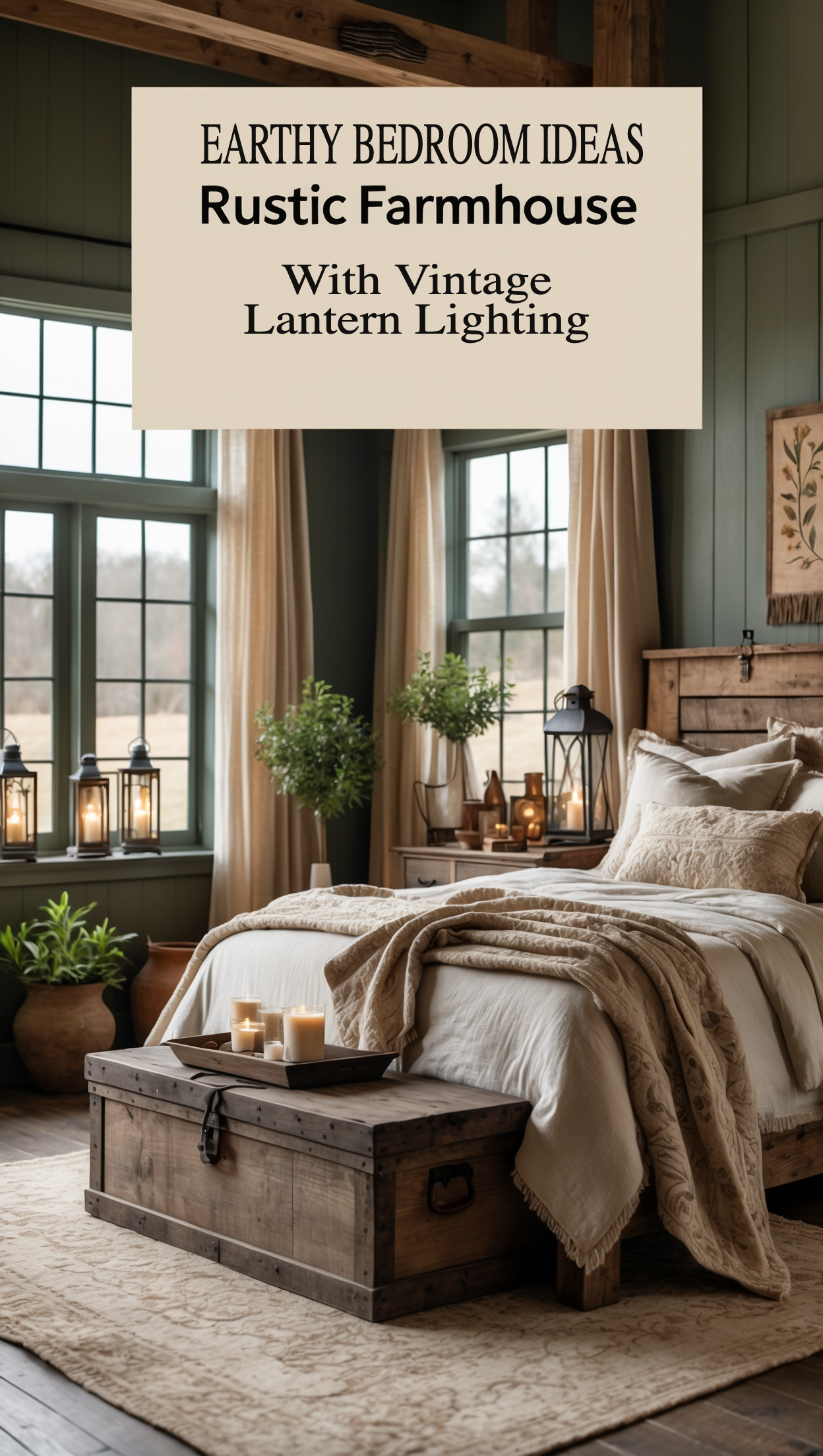
The honest simplicity of rustic farmhouse style paired with sage green accents creates an incredibly inviting and authentic bedroom retreat. Envisioning an 1800s farmhouse redesigned with sage green panels alongside reclaimed wood and wrought iron elements creates a space that honors the home’s agricultural heritage while feeling fresh and current.
This combination is compelling because sage green softens and modernizes traditional rustic elements without detracting from their character and history. The color seamlessly complements the weathered woods and vintage metals that define farmhouse style.
Benefits of Rustic Elements
Rustic farmhouse style creates a connection to simpler times, incorporating natural materials and honest craftsmanship that promote restful sleep and a sense of groundedness.
Enhancing Historical Character
Sage green complements the patina of aged wood and vintage elements, highlighting their character while adding a contemporary touch.
Pairing Sage with Vintage Lighting
Antique lanterns and vintage-inspired lighting fixtures create focal points of warmth and character against sage green backgrounds.
Steps to Achieve It
- Incorporate reclaimed wood through architectural elements, furniture, or accent pieces
- Add sage green through painted furniture, textiles, or a statement wall
- Include vintage or reproduction lantern lighting with antiqued metal finishes
- Layer bedding in natural fabrics like cotton and linen in complementary neutrals
- Display authentic farmhouse artifacts like antique tools or agricultural implements as art
- Add textural elements with woven baskets, wool throws, or handmade quilts
- Incorporate simple window treatments that maximize natural light
- Include plants or fresh-cut flowers in simple containers like mason jars or crocks


Picture This
In this rustic farmhouse bedroom, sage green beadboard creates a serene backdrop for a bed crafted from centuries-old barn wood. Vintage lanterns hang from exposed ceiling beams, casting a warm amber glow across handwoven quilts in complementary earth tones. A weathered chest serves as a nightstand, topped with beloved books and a simple pottery lamp. Morning light streams through simple linen curtains, highlighting the authentic patina of carefully preserved architectural details. The sage green elements don’t compete with the room’s rustic heritage—they enhance it, creating a space that feels rooted in history yet perfectly suited for contemporary life.
13. Futuristic Cozy Loft with Minimalist Design
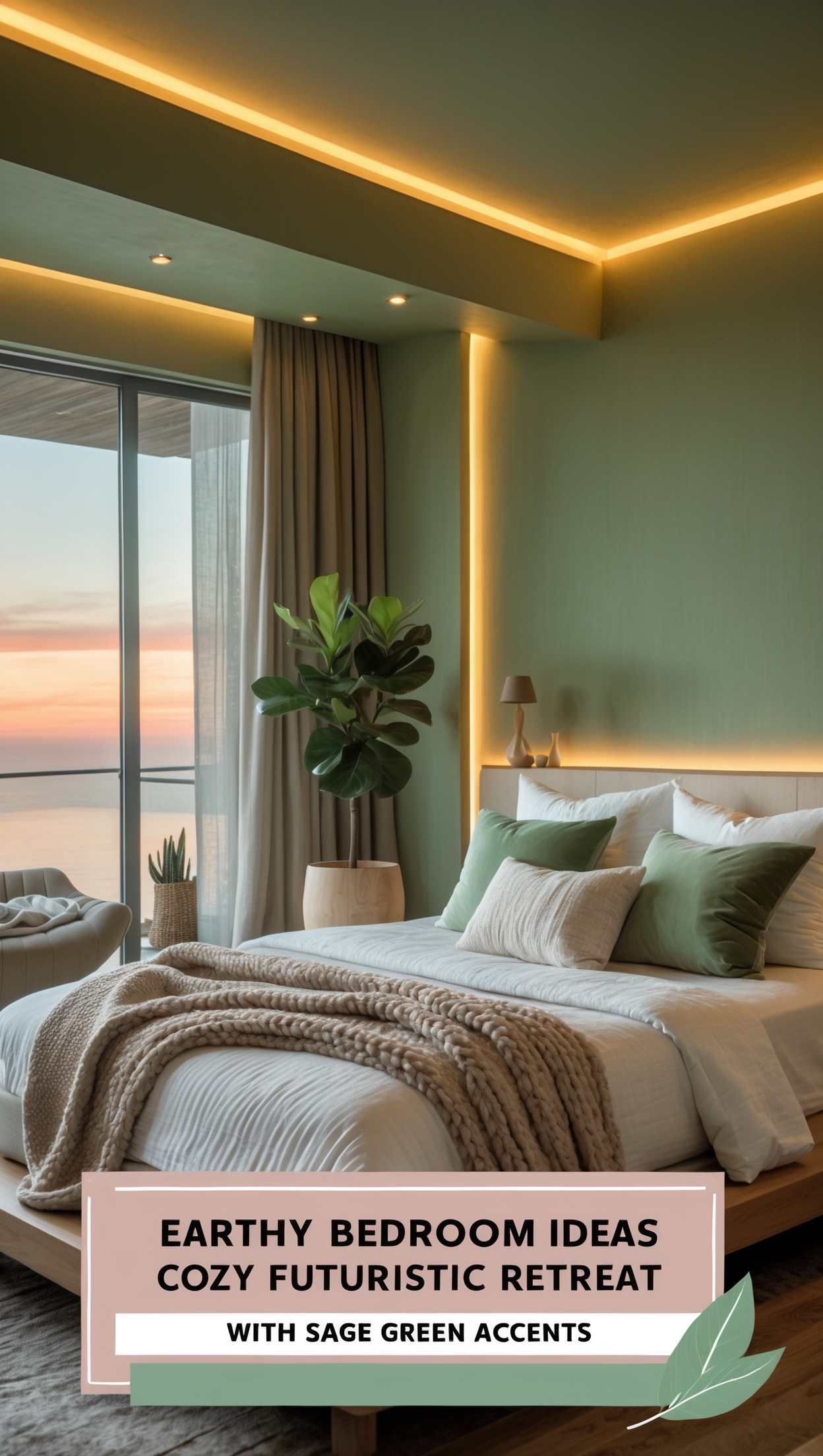
The bold juxtaposition of sleek, futuristic design elements against a sage green accent wall creates an unexpectedly stunning bedroom aesthetic. Imagining a space where sage green serves as an organic counterpoint to ultra-modern furnishings and smart home features offers a vision of a room that feels both innovative and grounded.
This combination works brilliantly due to the tension between the cutting-edge minimalism of the design and the timeless, natural quality of sage green—a color with deep roots in human history, now reimagined for spaces dedicated to future innovations.
Benefits of Minimalist Design
Futuristic minimalism eliminates visual clutter and excess, creating a clean, forward-thinking environment that promotes clear thinking and restful sleep.
Enhancing Technology Integration
Sage green softens the potentially cold feeling of integrated technology, creating a more inviting atmosphere in high-tech spaces.
Pairing Sage with Sleek Materials
The organic quality of sage green creates beautiful contrast against sleek materials like glass, chrome, and high-gloss finishes.
How to Create This Look
- Create a focal point with a sage green accent wall behind the bed
- Choose furniture with clean, geometric lines and minimal ornamentation
- Incorporate integrated technology like smart lighting, automated blinds, or hidden speakers
- Add metallic elements through chrome, brushed steel, or high-polish accessories
- Select bedding in crisp white or complementary neutrals with minimal texture
- Include statement lighting with architectural presence and programmable features
- Add 1-2 sculptural plants with strong architectural forms
- Display abstract art that incorporates sage green as a connecting element
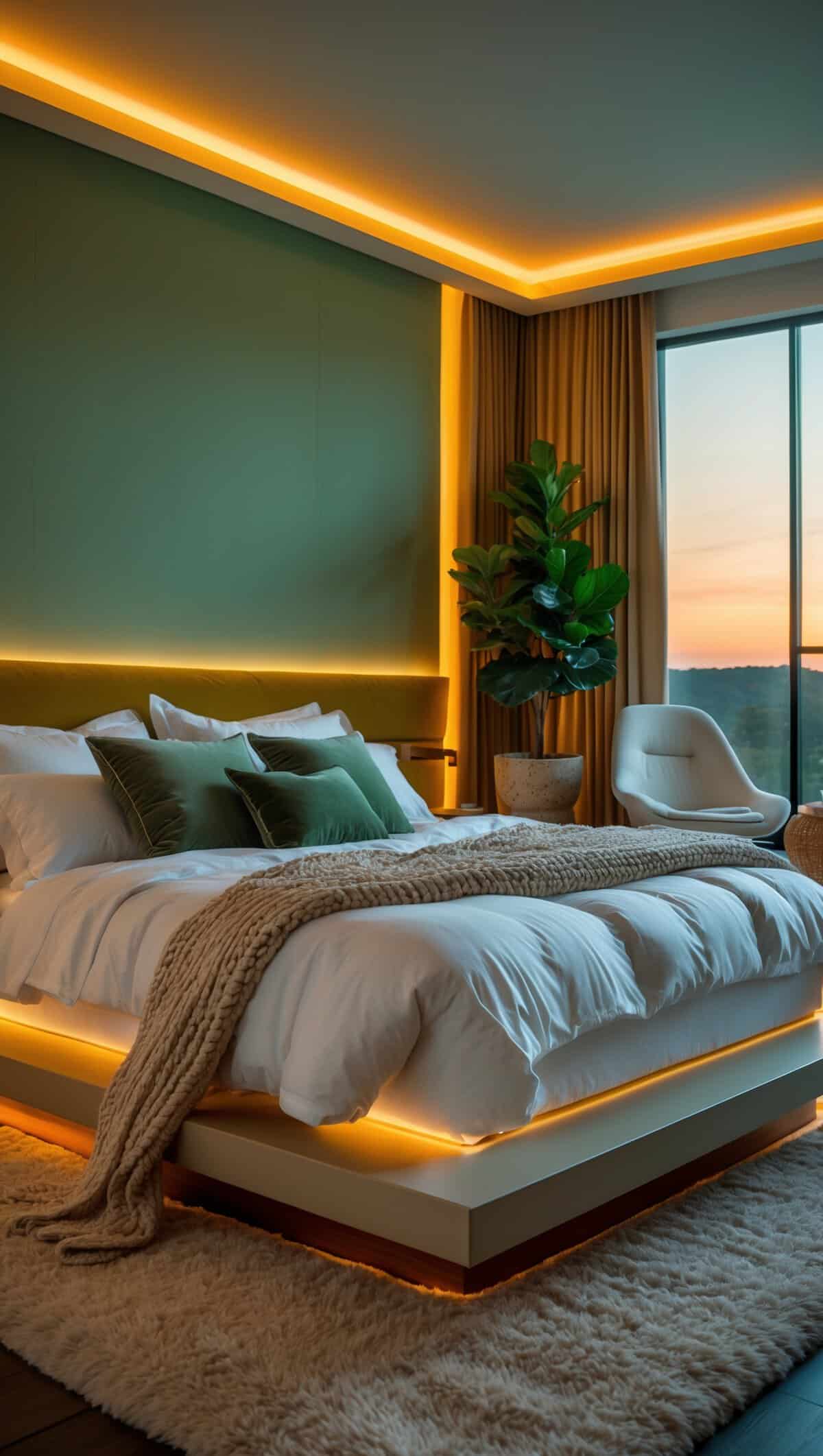
Picture This
This futuristic bedroom commands attention with its sage green accent wall serving as an organic counterpoint to sleek, minimalist furnishings. A platform bed appears to float above recessed floor lighting, while automated blinds silently adjust to optimize natural light. Integrated speakers and ambient lighting respond to voice commands, creating the perfect atmosphere with a single word. A single sculptural plant in a matte black container adds a touch of living energy to the space. The sage green wall doesn’t feel out of place in this high-tech environment—it feels like an intentional nod to humanity’s connection to nature, even as we embrace the future.
14. Tranquil Meditation Nook with Zen Accessories

Creating a dedicated meditation space within a bedroom has become increasingly popular, and for good reason! In the last house I lived in I designed a meditation nook for my sage green-themed bedroom, it transformed not just the aesthetics but the entire feeling and function of the space.
What I love about incorporating a meditation area is how it visually reminds you to take time for mindfulness and self-care, turning your bedroom from simply a place to sleep into a comprehensive wellness sanctuary. The sage green palette enhances this intention perfectly, providing a naturally calming backdrop that supports quiet contemplation.
Benefits of Meditation Spaces
Dedicated meditation areas promote regular mindfulness practice, creating physical and visual reminders to prioritize mental wellbeing daily.
Enhancing Mental Clarity
Sage green creates a distraction-free visual environment that facilitates meditation and promotes mental clarity and emotional balance.
Pairing Sage with Natural Textures
The simple elegance of sage green complements natural meditation accessories like bamboo mats, stone fountains, and wooden prayer beads.
Steps to Create This Look
- Identify a quiet corner of your bedroom with good natural light
- Paint this area in sage green or use sage green textiles to define the space
- Add a comfortable meditation cushion, low bench, or yoga mat in natural materials
- Include a small, low table for meditation accessories like singing bowls or incense
- Incorporate a small tabletop fountain or essential oil diffuser with calming scents
- Add soft lighting through candles, salt lamps, or adjustable fixtures
- Display meaningful objects that support your practice, like mala beads or stones
- Include plants that thrive in low-maintenance environments like succulents or peace lilies

Picture This
In the corner of this sage green bedroom, a perfectly proportioned meditation nook invites daily mindfulness practice. Morning light filters through sheer curtains, illuminating a handcrafted bamboo mat topped with a simple meditation cushion. A low wooden table holds a small brass singing bowl, a polished stone, and a beeswax candle waiting to be lit. The gentle sound of water trickles from a small ceramic fountain, while the scent of sandalwood lingers in the air. This isn’t just a decorative corner—it’s a sacred space within the bedroom where sage green walls create the perfect backdrop for turning inward and finding peace.
15. Sophisticated Monochrome Palette with Varying Shades of Sage Green
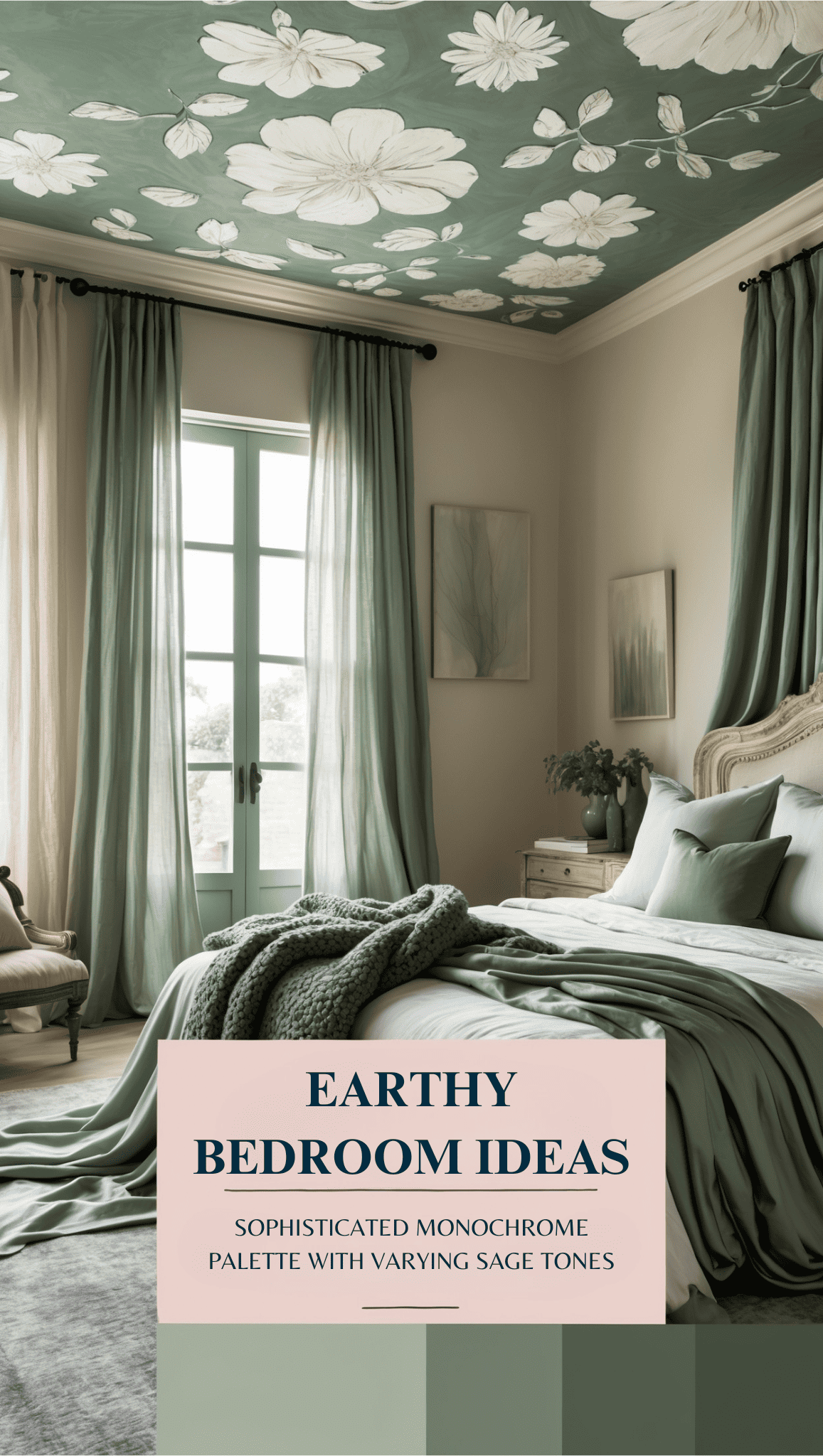
There’s something incredibly soothing about a monochromatic color scheme and working with different shades of sage green offers one of the most sophisticated and nuanced approaches to bedroom design. Envisioning a look that incorporates everything from the palest celadon to deep forest sage creates a dimensional space that feels both cohesive and visually rich.
This approach succeeds by using slight tonal variations to create depth and interest without introducing competing colors, preserving the serene, enveloping quality of the space.
Benefits of Monochromatic Design
A single-color palette creates visual cohesion and a sense of expansiveness, making any size room feel more spacious and intentionally designed.
Enhancing Color Perception
Using multiple shades of sage green helps train the eye to notice subtle color variations, creating a space that reveals itself differently throughout changing light conditions.
Pairing Light and Dark Sages
The contrast between pale and deep sage tones creates natural visual hierarchy without introducing competing colors that might disrupt the room’s restful quality.
Steps to Achieve It
- Select a sage green paint color card and choose 3-5 consecutive shades from lightest to darkest
- Paint walls in a middle tone, the ceiling in the lightest shade, and trim in a slightly darker tone
- Choose bedding in varying sage tones, mixing textures to create visual interest
- Add window treatments in another sage shade, either lighter or darker than the walls
- Incorporate furniture in natural wood tones that complement sage green
- Include plants with silver-sage foliage like eucalyptus or lamb’s ear
- Use artwork with primarily sage tones, or black and white photography in sage frames
- Add textural elements like sage green mohair throws or velvet pillows in deeper sage tones
Picture This
In this sophisticated sanctuary, the entire color story unfolds in shades of sage green, from the palest misty tone on the ceiling to the deep, velvety emerald of accent pillows. The walls, painted in a perfect middle-tone sage, provide a backdrop for a bed dressed in linens that shift subtly from silvery sage to a richer olive. Natural linen curtains in the palest green filter light that changes the perception of color throughout the day. Textural contrast comes through a chunky knit throw, smooth velvet cushions, and a nubby wool rug—all in carefully calibrated sage tones. The result is a space that feels both cohesive and intriguingly complex.

16. Luxurious Retreat with Plush Sage Green Rugs
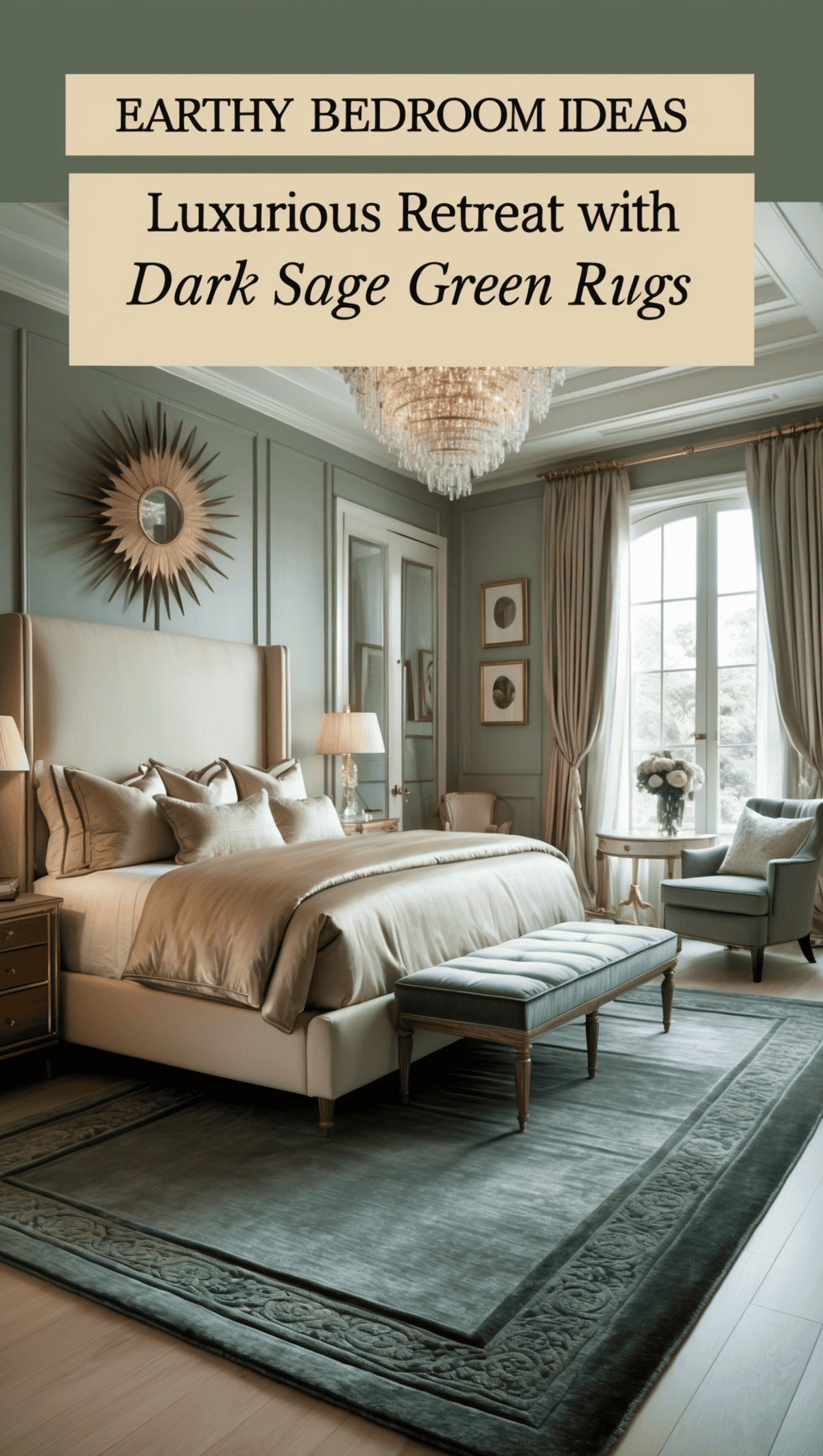
There’s something undeniably indulgent about stepping onto plush rug first thing in the morning, and sage green adds an unexpected earthy sophistication to this luxurious feature. Once I stayed at a mountain lodge the bedroom, had sage green area rugs that transformed the space into a cozy retreat that felt connected to the pine forest outside.
What makes this design choice so effective is how it creates a continuous field of color that grounds the space while adding considerable warmth and sound absorption, perfect for creating a truly restful environment.
Benefits of Carpet Flooring
Wall-to-wall carpeting provides superior sound insulation and temperature regulation while creating a consistently comfortable underfoot experience throughout the room.
Enhancing Sound Quality
Plush sage carpeting absorbs ambient noise, creating a noticeably quieter sleep environment that contributes to deeper, less interrupted sleep.
Pairing Sage with Ornate Elements
The understated nature of sage green carpeting allows more decorative elements like ornate chandeliers to shine without creating visual competition.
How to Recreate It
- Choose a high-quality carpet in sage green with adequate padding for maximum comfort
- Select luxurious bedding in complementary neutrals like ivory, champagne, or taupe
- Add a statement chandelier or pendant light that creates interesting shadows on the ceiling
- Include substantial nightstands with significant storage to minimize clutter
- Incorporate a tufted headboard in a complementary texture like velvet or linen
- Add dimmable lighting options throughout the room for adjustable ambiance
- Include full-length mirrors to create the impression of extended space
- Consider custom drapery that puddles slightly on the carpet for ultimate luxury
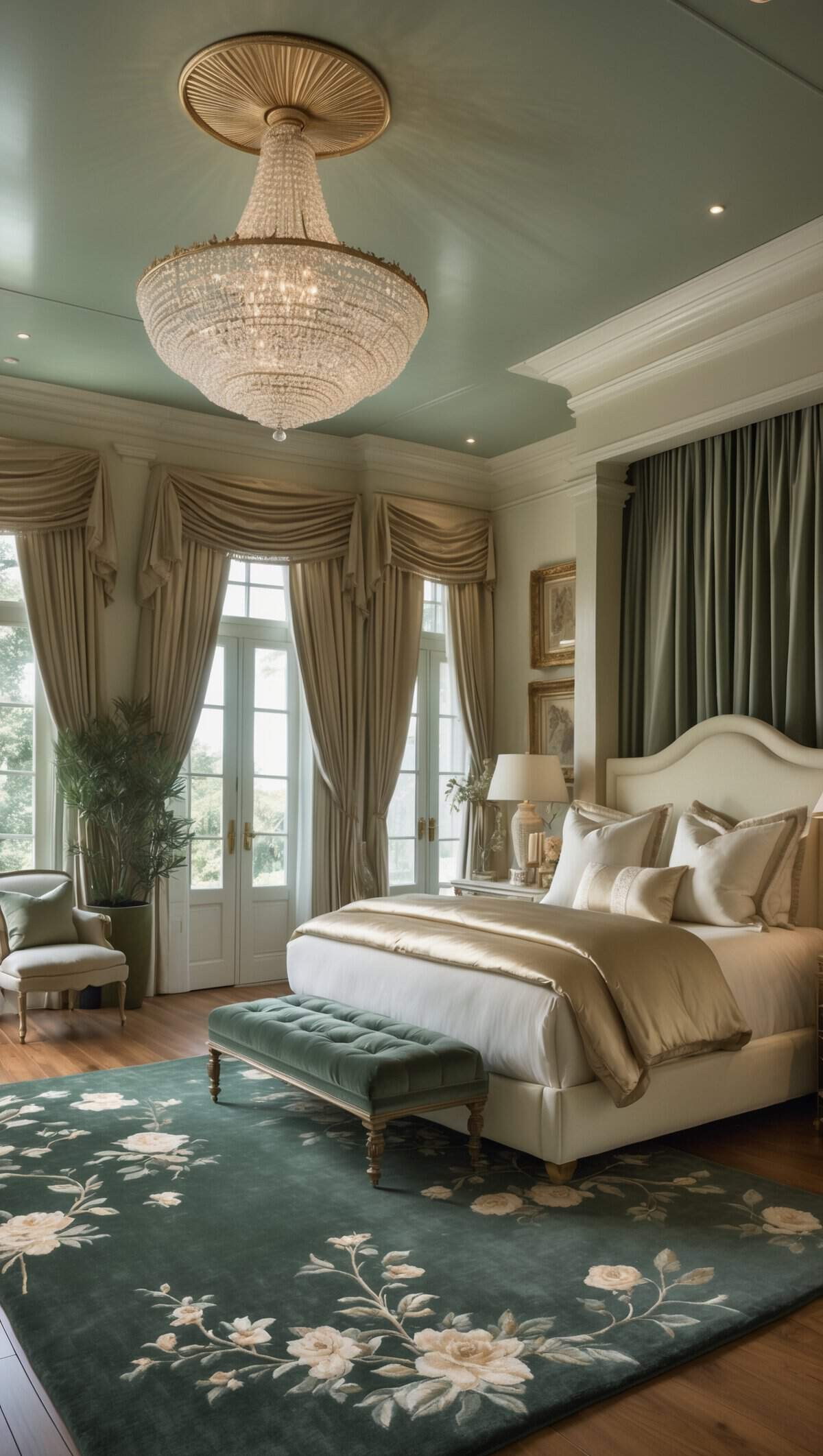
Picture This
In this sumptuous retreat, plush sage green carpeting extends wall to wall, creating a continuous field of softness underfoot. A crystal chandelier casts prismatic patterns across a tufted ivory headboard, while weighty linen curtains in pale gold frame the windows. Substantial nightstands hold elegant lamps with silk shades, casting a warm glow at bedtime. The sage carpeting doesn’t just anchor the space—it creates a sensory experience, absorbing sound and providing luxurious warmth that contrasts beautifully with cool sheets. This isn’t just a bedroom; it’s a true sanctuary where every surface invites touch and comfort.
17. Modern Minimalist Space with Floating Sage Green Shelves
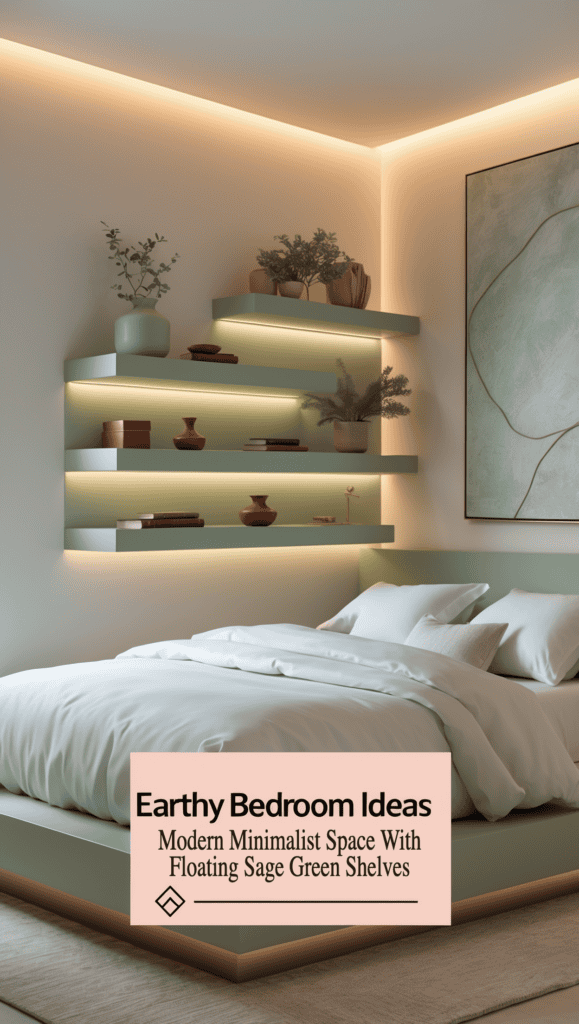
I’ve always been fascinated by the powerful visual impact of floating shelves, and when executed in sage green, they bring a beautiful organic element to minimalist spaces. When redesigning my office, I installed a series of floating sage green shelves that provided both essential storage and a striking architectural feature.
What makes this concept so effective is how it maintains the clean, uncluttered aesthetic of minimalism while introducing color in a functional way that doesn’t overwhelm the space—perfect for those who appreciate simplicity but crave more visual warmth than traditional minimalism offers.
Benefits of Floating Shelves
Floating shelves provide storage and display space without the visual weight of traditional cabinetry, maintaining an open, airy feeling.
Enhancing Architectural Interest
The horizontal lines of floating shelves draw the eye around the room, creating movement and interest in a minimalist space without excessive decoration.
Pairing Sage with Curated Displays
The natural, neutral quality of sage green creates the perfect backdrop for thoughtfully curated objects, allowing them to stand out while remaining cohesive.
How to Style It
- Install 3-5 floating shelves in sage green, either matching the wall color or contrasting slightly
- Arrange shelves asymmetrically for visual interest, maintaining practical reach heights
- Display a carefully edited collection of objects with personal meaning and aesthetic value
- Incorporate natural elements like small plants, stones, or wooden objects
- Include practical storage solutions like minimalist boxes or baskets in complementary colors
- Add subtle lighting with small LED strips underneath shelves for evening ambiance
- Keep the rest of the room simple with white bedding and minimal furniture
- Consider a single piece of oversized art as a focal point on a non-shelf wall

Picture This
In this modern minimalist bedroom, a series of floating sage green shelves creates horizontal architecture against pristine white walls. Each shelf holds a carefully considered arrangement—a small ceramic vase with a single stem, a stack of favorite books with neutral spines, a handcrafted wooden box holding essentials. LED lighting beneath each shelf activates at dusk, creating a warm glow that highlights the sage color. The platform bed with crisp white linens remains the room’s anchor, while the shelves transform an otherwise simple space into a personal gallery of meaningful objects against that perfect sage green background.
18. Cottagecore-Inspired Room with Lace Curtains and Sage Green Walls
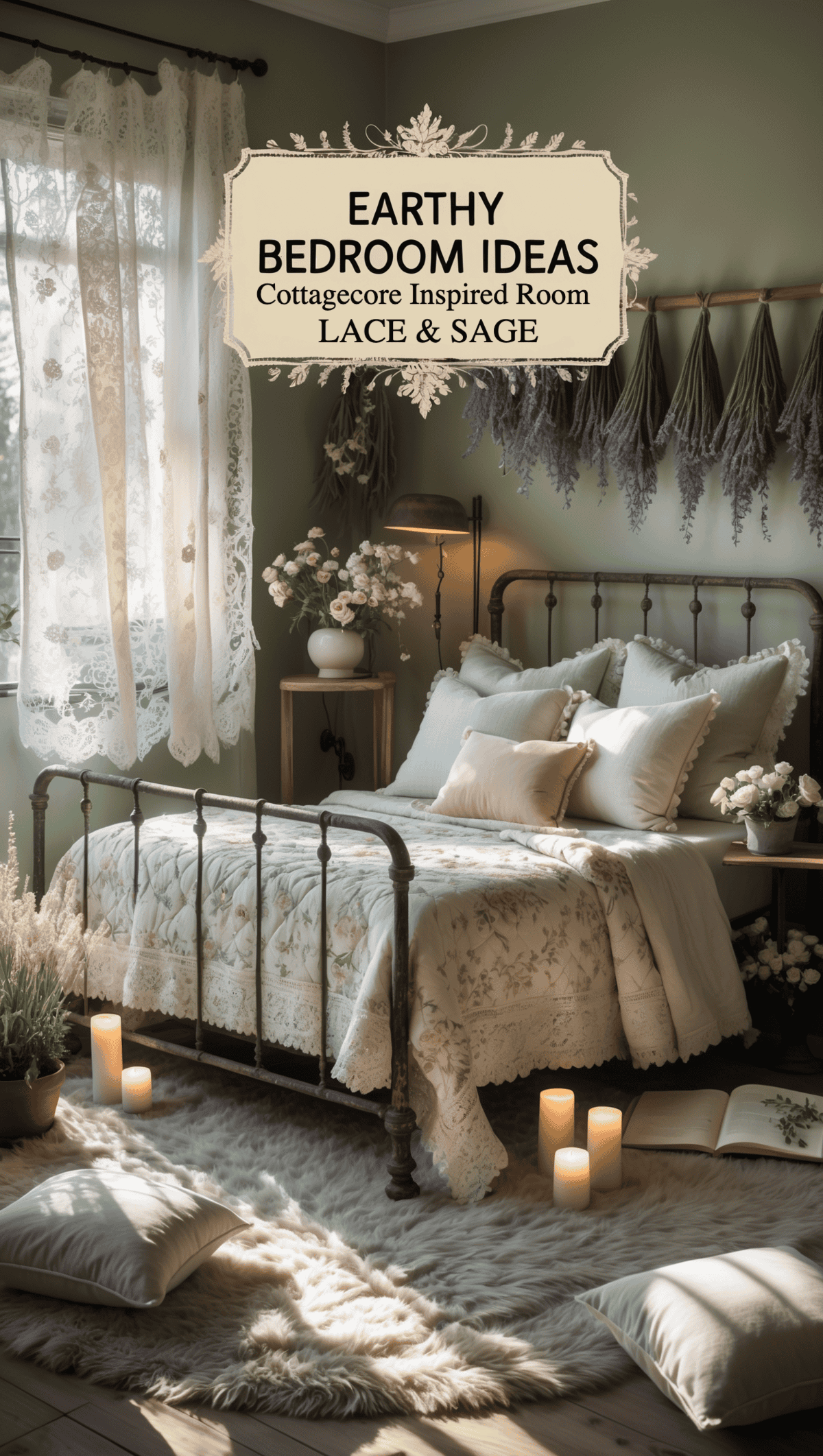
There’s something eternally charming about the cottagecore aesthetic that reconnects us with simpler times and handcrafted beauty. My friend recently transformed her guest bedroom with sage green walls and delicate lace curtains, creating a space that immediately evoked a sense of pastoral romance and vintage comfort.
What makes this combination so magical is how the sage green references herb gardens and meadows, while the lace curtains filter light in the most enchanting way, casting patterns across the room that change throughout the day like dappled sunshine through leaves.
Benefits of Cottagecore Design
The cottagecore aesthetic promotes disconnection from digital overwhelm and reconnection with handcrafted elements, nature, and simpler pleasures.
Enhancing Natural Light
Lace curtains diffuse natural light beautifully against sage green walls, creating a soft, ever-changing play of patterns throughout the day.
Pairing Sage with Vintage Elements
Sage green provides the perfect pastoral backdrop for vintage furniture, floral patterns, and handcrafted textiles that define cottagecore style.
Steps to Achieve It
- Paint walls in a soft, slightly muted sage green with warm undertones
- Hang genuine or reproduction lace curtains that filter light without blocking it completely
- Incorporate a wrought iron or brass bed frame with vintage-inspired lines
- Add floral patterns through quilts, pillowcases, or a single wallpapered accent wall
- Include handcrafted elements like embroidered pillows or a crocheted throw
- Display collections of vintage botanical prints or pressed flowers in simple frames
- Add a small writing desk with a pretty chair for letter writing or journaling
- Incorporate dried flowers or herbs in small bundles or wreaths on the walls

Picture This
Stepping into this cottagecore haven feels like entering a secret garden bedroom. Sage green walls create the perfect backdrop for delicate lace curtains that cast intricate patterns across a vintage wrought iron bed. A handmade quilt with faded floral patches drapes casually over crisp white sheets, while embroidered pillowcases add charming detail. A small writing desk by the window holds a pottery vase with fresh wildflowers, a handbound journal, and a collection of pressed botanicals in simple frames. Bundles of dried lavender and eucalyptus hang from a wooden rack, filling the room with subtle herbal fragrance that complements the sage walls perfectly.
19. Contemporary Art-Lover’s Setup with Large Sage Green Murals
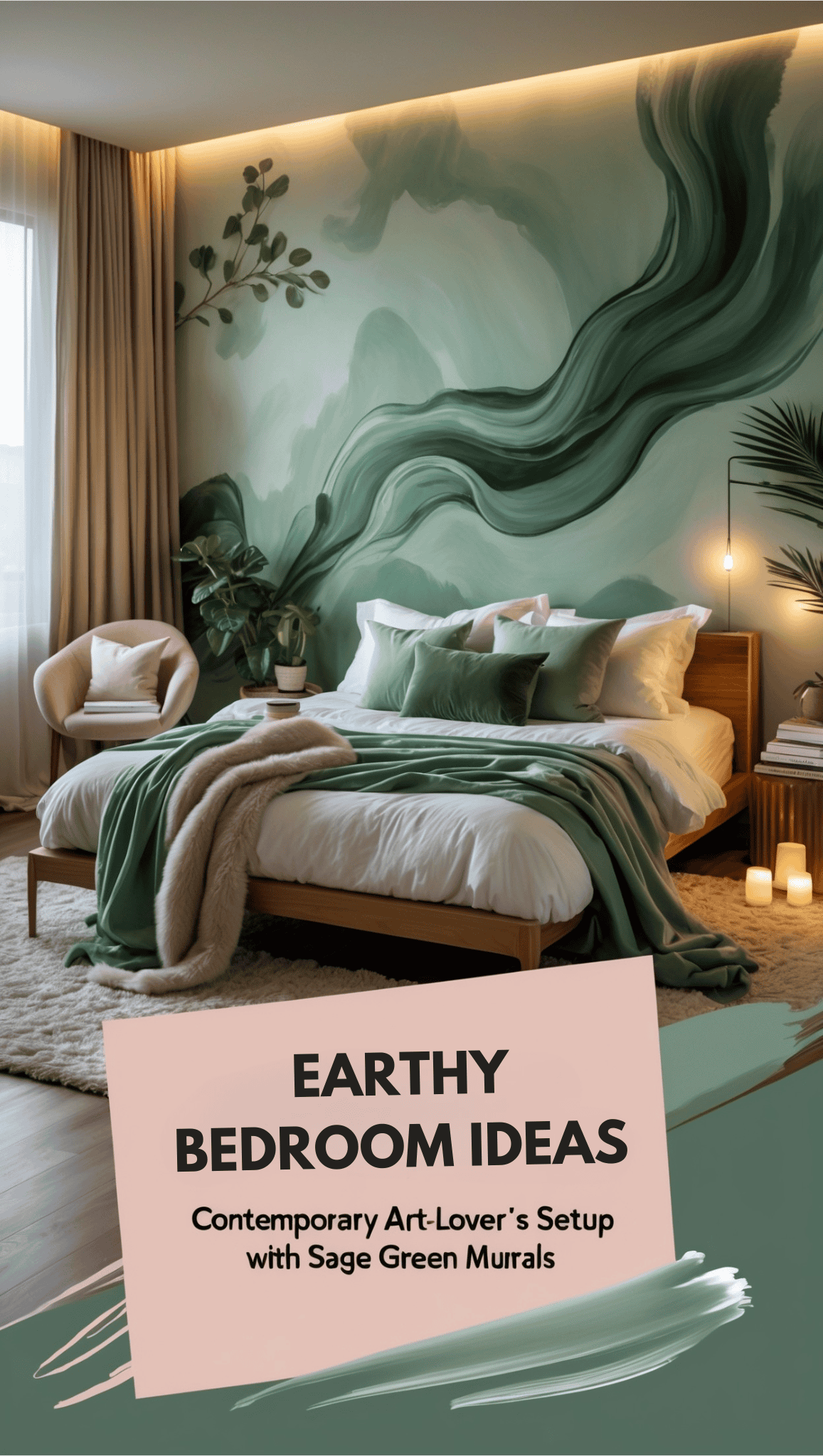
There’s something boldly contemporary about using large-scale wall murals, and when executed in varying shades of sage green, they create a stunning artistic statement that remains connected to nature. A friend of mine, an art collector, transformed their bedroom into a gallery-like space by commissioning a custom abstract mural in sage green tones.
This approach is effective because it elevates sage green from a simple wall color to an artistic expression, creating a space that is both intellectually stimulating and visually restful—ideal for someone who appreciates contemporary design but still wants their bedroom to promote good sleep.
Benefits of Mural Walls
A large-scale mural eliminates the need for additional artwork, creating a cohesive visual statement that simplifies the rest of the room’s design.
Enhancing Spatial Perception
Abstract sage green murals can create the illusion of expanded space through depth and movement, making the room feel larger and more dynamic.
Pairing Sage with Simple Lines
The organic complexity of a sage green mural pairs beautifully with simple, architectural furniture that doesn’t compete with the wall’s visual interest.
How to Create This Look
- Commission a custom mural or select a high-quality wallpaper mural in sage green tones
- Keep furniture minimal with clean lines and neutral upholstery
- Choose bedding in solid colors that complement but don’t compete with the mural
- Add architectural lighting that highlights the mural’s best features
- Incorporate 1-2 sculptural elements that reference shapes or lines found in the mural
- Select flooring in a neutral tone that grounds the space without competing with the walls
- Add minimal window treatments that frame views without blocking natural light
- Include one statement piece of furniture that complements the mural’s aesthetic

Picture This
In this art-lover’s sanctuary, an abstract sage green mural flows across the main wall, creating a mesmerizing topographical landscape of various green tones and textures. A platform bed with architectural lines sits centered beneath the mural, dressed simply in high-quality white linens that don’t compete for attention. A single sculptural floor lamp arcs dramatically overhead, its light washing the mural with subtle illumination that reveals new details after dark. Minimal furnishings in natural materials complete the space, allowing the sage green artwork to remain the uncontested focal point of this gallery-like bedroom.
20. Subtle Earthy Tones Combined with Sage Green for a Warm, Grounding Space

There’s something deeply reassuring about a bedroom that embraces a full palette of earth tones, and sage green acts as the perfect bridge between cooler and warmer elements within this spectrum. When designing a bedroom retreat, I used sage green as my starting point and built a rich tapestry of terracotta, ochre, and umber around it, creating a harmonious blend of natural hues that evoke the serenity of forest floors and the warmth of sunlit canyons, enveloping the space in a balanced, earthy elegance.
What makes this combination so effective is how it references the full range of colors found in nature—from forest floors to canyon walls—creating a space that feels authentically connected to the earth and inherently balanced between cool and warm elements.
Benefits of Earth Tone Palettes
A comprehensive earth tone palette creates visual harmony that mimics natural environments, triggering evolutionary responses of safety and relaxation.
Enhancing Color Temperature Balance
Sage green bridges cooler grays and warmer terracottas, creating a perfectly balanced palette that works in all seasons and light conditions.
Pairing Sage with Rich Textures
Earth tones naturally lend themselves to textural exploration, with sage green providing the perfect foundation for layers of tactile interest.
Steps to Recreate It
- Start with sage green as your base through paint, bedding, or a substantial furniture piece
- Add terracotta elements through textiles, pottery, or small furniture accents
- Incorporate natural wood in mid-tone finishes like oak or walnut
- Include textural contrast through woven baskets, clay pots, and natural fiber textiles
- Add small accents in ochre or amber through decorative objects or artwork
- Choose metals in bronze or antiqued brass rather than chrome or silver
- Incorporate plants with reddish or bronze undertones to complement the palette
- Layer multiple textiles in complementary earth tones for depth and comfort

Picture This
This grounding bedroom embraces the full spectrum of earth tones, with sage green walls creating the perfect backdrop for layers of natural color and texture. A handwoven wool rug in terracotta anchors the space, while the bed features linens in gradations from sage to olive. Accent pillows in ochre and amber add warmth, complemented by a chunky knit throw in oatmeal. Pottery in various earth tones displays small plants with bronze-tinged foliage, while woven baskets provide both storage and visual texture. The room doesn’t just look earthy—it feels like a physical embrace of natural elements and colors.
21. Romantic Vintage Boudoir with Sage Green Ruffled Bedlinen
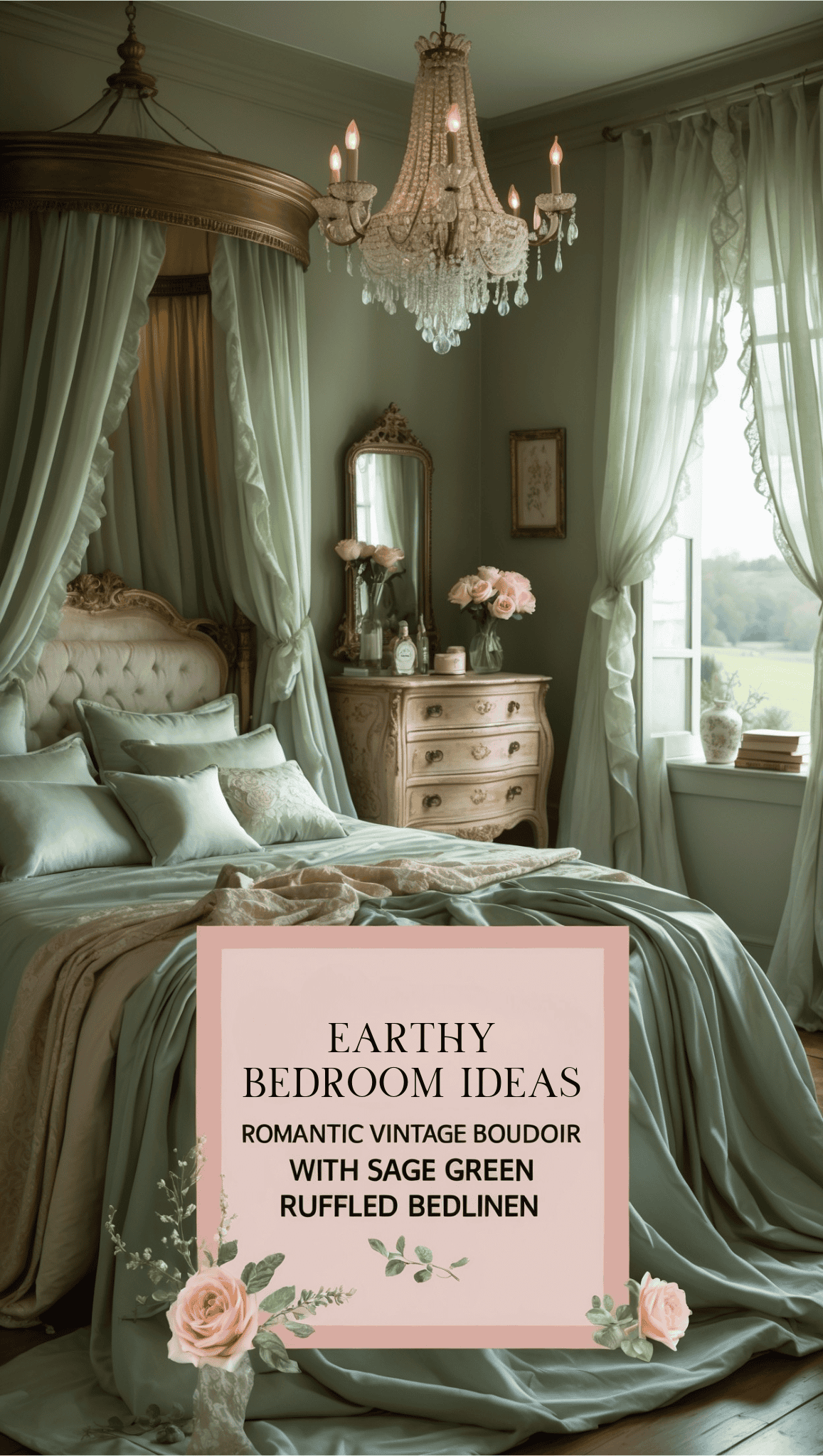
I’ve always been captivated by bedrooms that embrace gentle femininity without becoming overly frilly, and I recently saw an inspiring example of this in a friend’s home. They combined sage green with soft ruffles to achieve a perfect balance of romance and sophistication in their guest bedroom.
This pairing is so appealing because the muted sage tone tempers the potential sweetness of ruffles, creating a look that is both indulgent and refined—perfect for those who appreciate romantic design without excess sentimentality.
Benefits of Romantic Elements
Thoughtfully incorporated romantic details create a sense of specialness and indulgence that transforms a bedroom from purely functional to emotionally nurturing.
Enhancing Textile Interest
Ruffles in sage green create wonderful movement and shadow play while adding sophisticated texture without the fussiness of floral patterns.
Pairing Sage with Antique Woods
The subtle coloration of sage green ruffled textiles provides the perfect complement to the warm patina of antique wooden furniture pieces.
How to Style It
- Start with sage green ruffled duvet cover and pillowcases as your foundation
- Choose antique or reproduction furniture with graceful lines and some patina
- Add a vintage-inspired vanity with a pretty mirror and delicate accessories
- Include soft, ambient lighting through table lamps with fabric shades
- Incorporate antique picture frames with black and white or sepia photographs
- Select window treatments with subtle feminine details like gentle gathers or tie-backs
- Add a plush area rug for comfort underfoot and sound absorption
- Include a comfortable chair for reading or putting on shoes
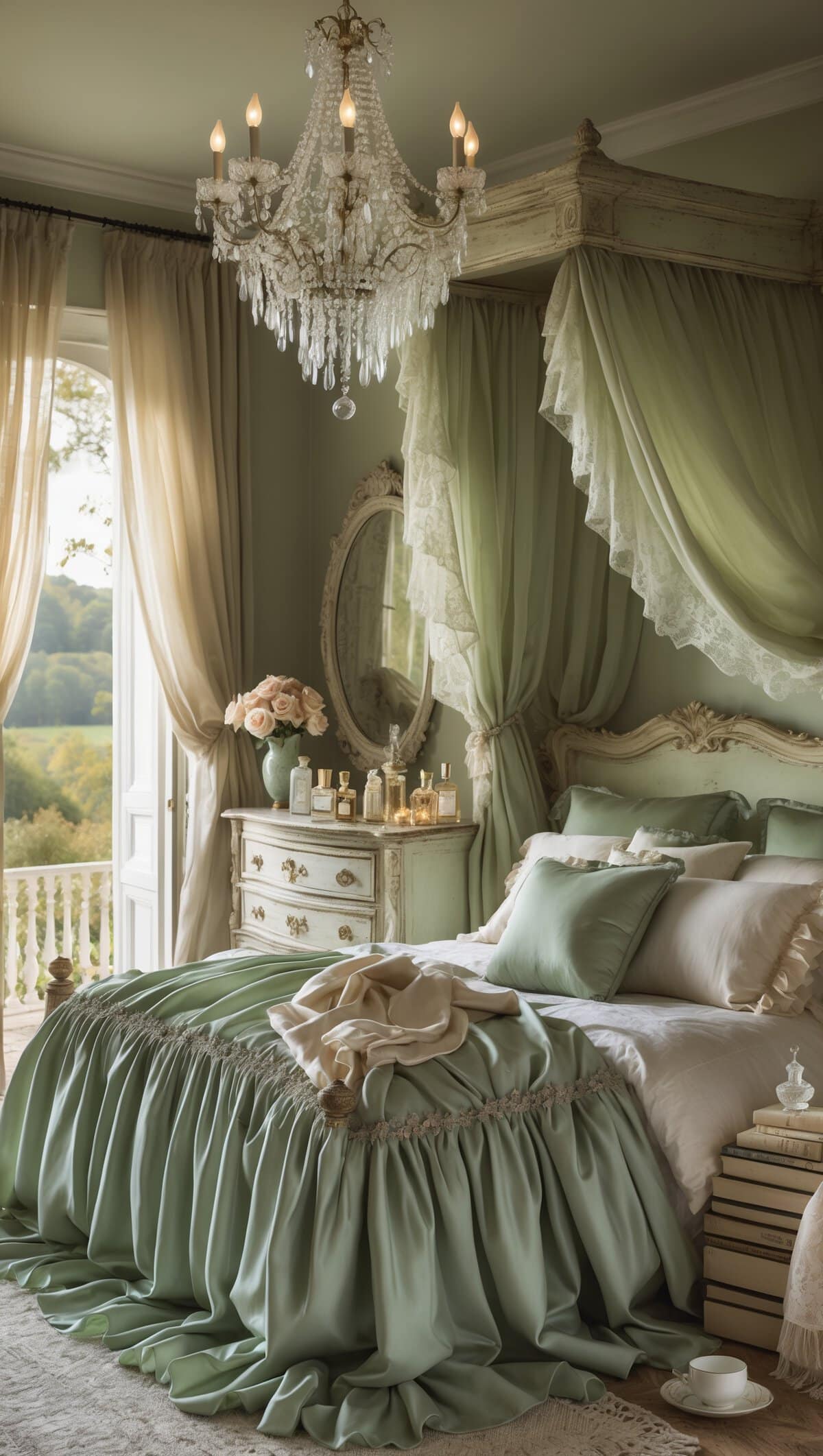
Picture This
In this romantic sanctuary, a bed adorned with sage green ruffled linens becomes a cloud-like focal point, the delicate fabric catching light and shadow with every gentle fold. An antique dresser with original brass hardware provides character and history, while vintage silver-backed brushes and perfume bottles create a tableau of feminine elegance on top. A small chandelier casts a warm glow across the space, highlighting the textural interplay between smooth sage ruffles and the rich patina of wooden furniture. Fresh flowers in a simple ceramic vase add a touch of nature that complements the sage green perfectly.
22. Nature-Infused Space with Sage Green Wallpaper and Botanical Motifs
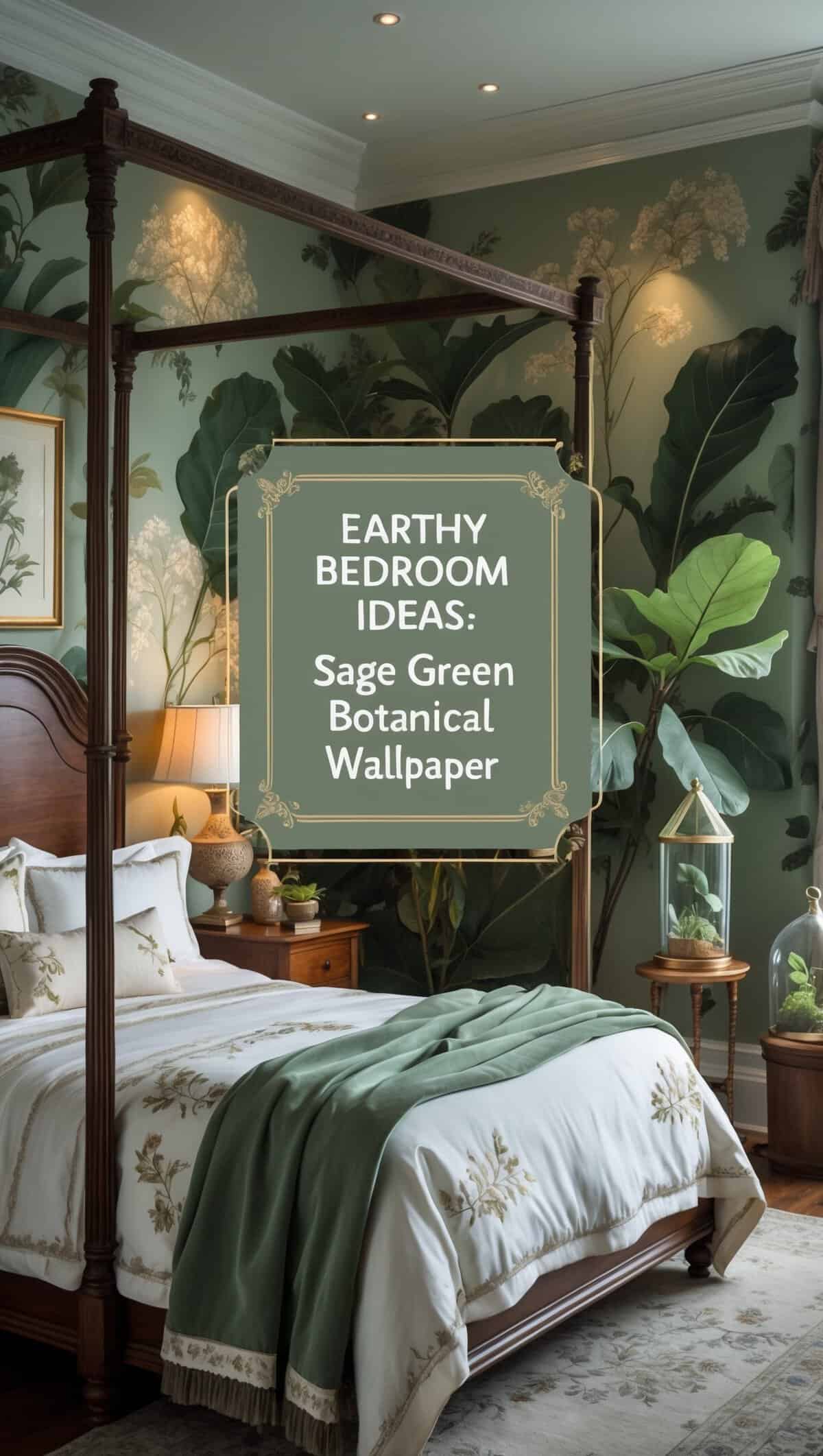
There’s something magical about botanical wallpaper that allows you to bring the intricate beauty of the natural world indoors in the most artistic way. I recently visited a boutique hotel renowned for its biophilic design, where I saw a room transformed with sage green wallpaper featuring delicate botanical illustrations.
This approach is truly special because it surrounds you with stylized representations of nature, offering more refinement than literal outdoor elements while still providing the psychological benefits of being close to nature. The sage green background creates the perfect canvas for these botanical details to shine without overwhelming the senses.
Benefits of Botanical Patterns
Surrounding yourself with botanical imagery provides many of the same psychological benefits as spending time in nature, including stress reduction and improved mood.
Enhancing Plant Connections
Sage green botanical wallpaper creates a perfect backdrop for actual houseplants, reinforcing the connection to nature through both illustration and living elements.
Pairing Sage Wallpaper with Simple Furnishings
The visual detail of botanical wallpaper is best complemented by simple, refined furniture that doesn’t compete with the wall’s natural artistry.
Steps to Achieve It
- Select a high-quality sage green wallpaper featuring botanical illustrations in a scale appropriate to your room size
- Choose whether to paper all walls for an immersive effect or create a single accent wall
- Select bedding in solid colors that complement the wallpaper’s palette—ivory, soft gold, or deeper sage
- Incorporate actual plants that reference species found in the wallpaper if possible
- Add furniture in natural materials with simple lines that won’t compete with the wallpaper
- Include minimal artwork that complements rather than competes with the botanical theme
- Select lighting that casts interesting shadows, enhancing the dimensional quality of the space
- Add a few decorative objects in materials found in nature like wood, stone, or ceramic
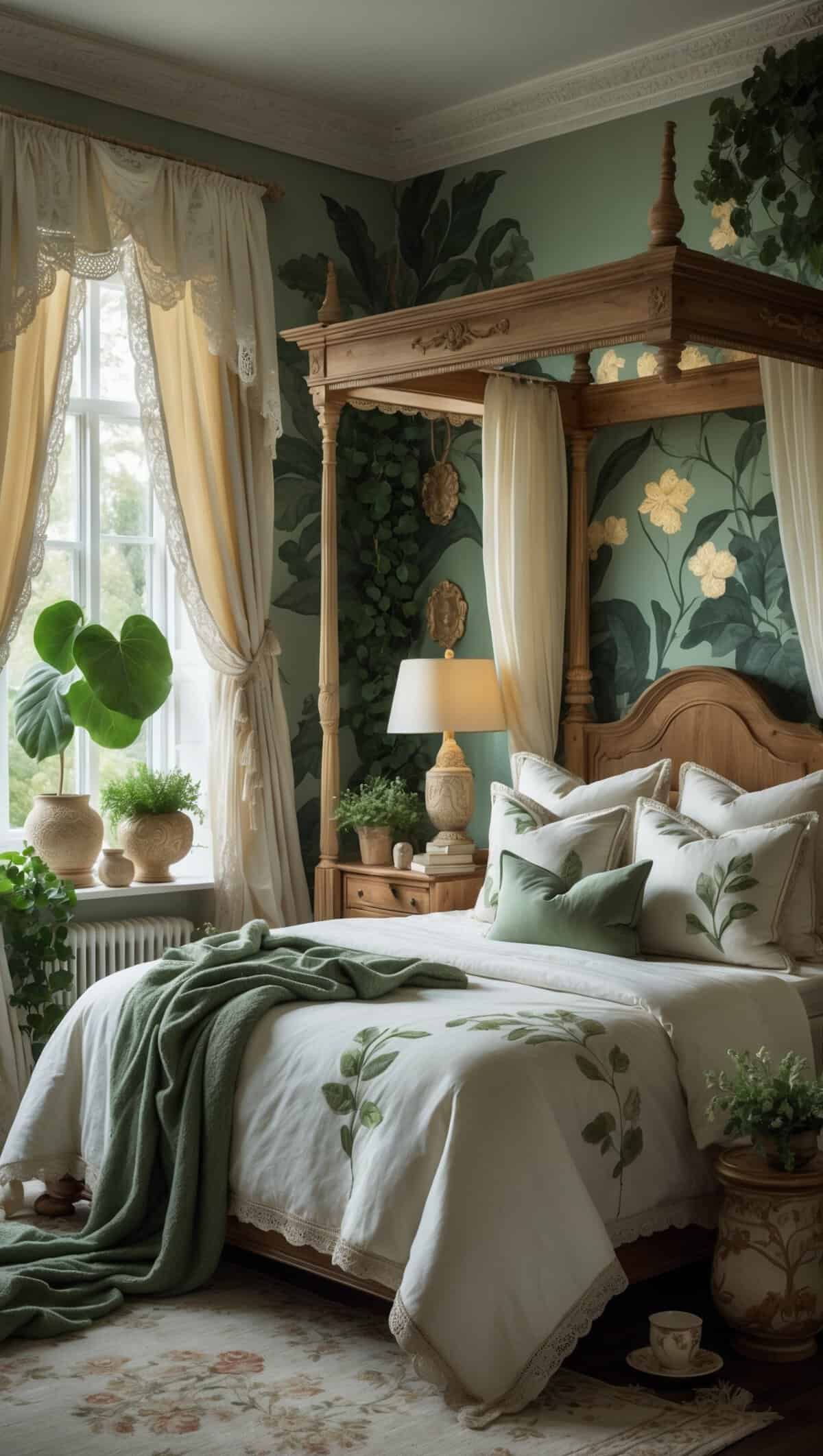
Picture This
In this botanical haven, sage green wallpaper adorned with delicate ferns, flowers, and leaves creates a sophisticated indoor garden. The pattern’s fine details reveal themselves differently throughout the day as lighting changes, rewarding close attention like a walk through nature. A simple wooden bed with crisp white linens provides a restful clearing in this illustrated forest, while actual potted ferns echo their painted counterparts nearby. Ceramic vessels in complementary sage tones hold additional plants, creating conversation between the two-dimensional and three-dimensional natural elements. This room doesn’t just reference nature—it creates a permanent artistic connection to the botanical world.
23. Tastefully Eclectic Design with Sage Green Contrasting Against Metallics

There’s something wonderfully unexpected about pairing the organic earthiness of sage green with the industrial character of metallic elements. When designing a bedroom with a friend who collects both vintage and contemporary pieces, we used sage green as our unifying color against an eclectic mix of metallic accents.
What makes this combination so striking is the visual tension between the natural, matte quality of sage green and the reflective surfaces of various metals—creating a space that feels simultaneously grounded and dynamic, perfect for someone with diverse taste who still wants a cohesive bedroom.
Benefits of Eclectic Design
Thoughtfully executed eclectic spaces allow for personal expression and evolution over time, accommodating new finds without requiring complete redesign.
Enhancing Metallic Elements
Sage green’s natural matte finish provides the perfect backdrop for metallic accents to shine, creating beautiful reflective moments throughout the space.
Pairing Sage with Mixed Metals
Using sage green as a constant allows the mixing of different metal finishes—brass, copper, chrome—without creating visual chaos.
How to Create This Look
- Start with sage green as your foundation through paint, bedding, or a substantial upholstered piece
- Incorporate a mix of metal finishes through lighting fixtures, furniture frames, and decorative objects
- Add vintage and contemporary pieces that speak to your personal style and history
- Include textural elements like velvet, linen, or wool to soften the metallic components
- Select artwork that incorporates both your sage green base and some of your metallic accents
- Add plants with silver-sage foliage to reinforce your color story while adding life
- Incorporate mirrors or reflective surfaces that multiply light and make the space feel larger
- Balance distribution of metallic elements around the room rather than clustering them in one area
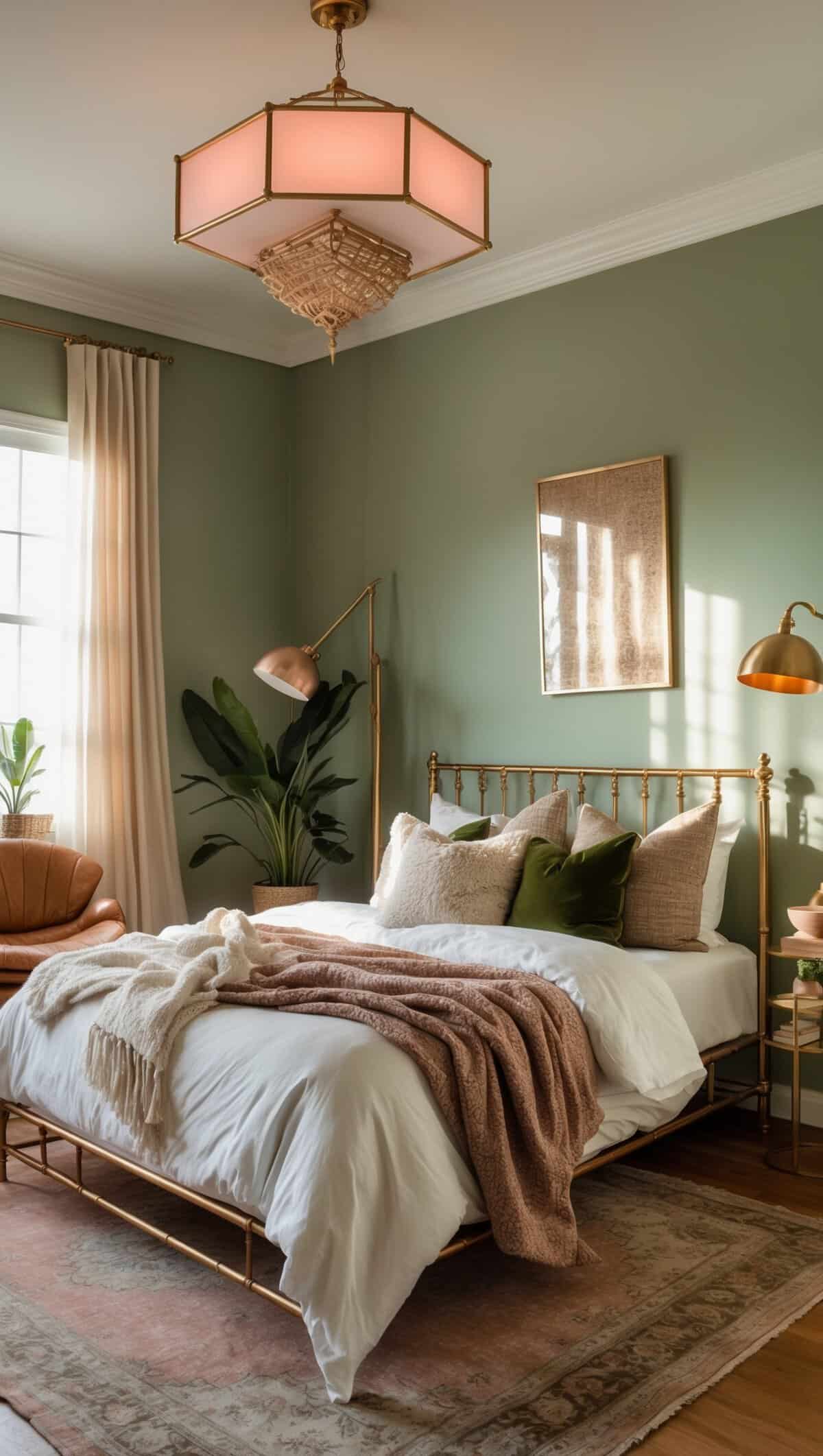
Picture This
In this tastefully eclectic bedroom, sage green walls provide a serene backdrop for a carefully curated collection of metallic elements. A vintage brass bed frame anchors the space, while a contemporary chrome floor lamp arcs dramatically nearby. A copper mirror reflects light across the room, its warm tone contrasting beautifully with the cool sage walls. The bed features simple sage linen bedding adorned with velvet pillows in deeper forest green, creating textural variety against the reflective metals. Small collections of treasured objects—some vintage, some new—create personal vignettes on surfaces throughout the room, unified by the consistent sage backdrop despite their diverse origins.
24. Versatile Neutral Base with Smokey Sage Green Highlights
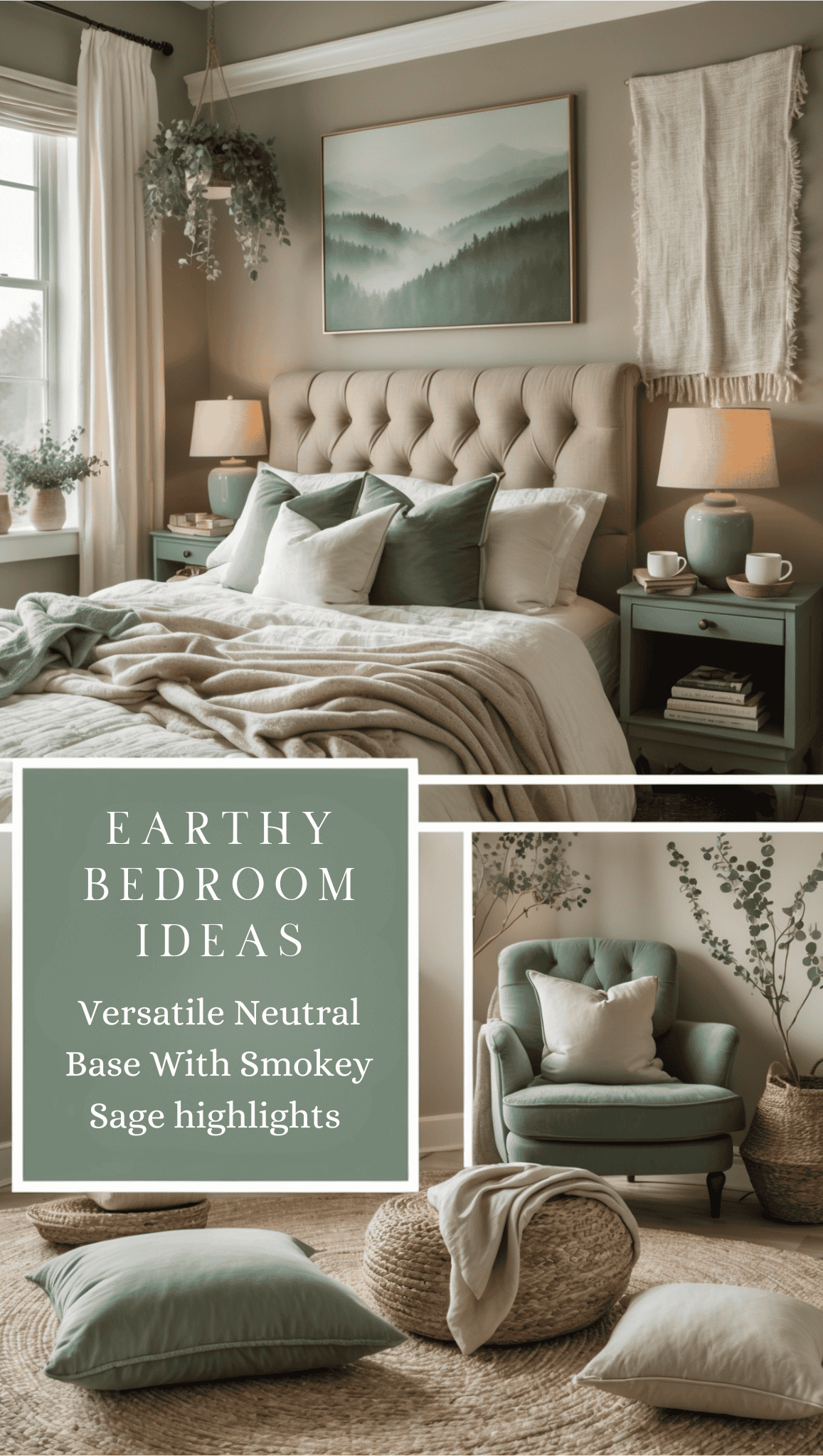
Visiting a friend’s artfully designed home opened my eyes to the sophistication of a primarily neutral room enhanced by subtle sage green accents. This setup felt exceptionally calm and distinctive, showing how sage green can serve as an elegant focal point amidst a sea of neutrals.
What makes this style work so well is that it maintains the versatile, timeless quality of neutrals while incorporating just enough color to prevent the space from feeling flat or uninspired. The smokey sage adds an essential touch of nature and personality without committing to a fully colored room.
Benefits of Neutral Foundations
A primarily neutral room creates a flexible foundation that can evolve easily with changing tastes or seasons without major renovation.
Enhancing Visual Tranquility
Limited color usage creates a visually quiet environment that promotes better sleep and reduces cognitive load in your rest space.
Pairing Sage with Varied Neutrals
Sage green highlights complement both warm and cool neutrals, from creamy whites to deep charcoals, making it incredibly versatile.
Steps to Recreate It
- Start with neutral walls, flooring, and large furniture pieces in varying tones of white, beige, or gray
- Add sage green through strategic accents like throw pillows, a small occasional chair, or a throw blanket
- Include one larger sage statement piece like a headboard, substantial artwork, or area rug
- Incorporate natural materials like wood, stone, and natural fibers in neutral finishes
- Add multiple textures through textiles and materials to prevent the neutral base from feeling flat
- Include metallic accents in subtle champagne or brushed nickel rather than high-shine options
- Consider sage green ceramic table lamps as functional accent pieces with presence
- Maintain abundant negative space to highlight the intentionality of your sage green moments
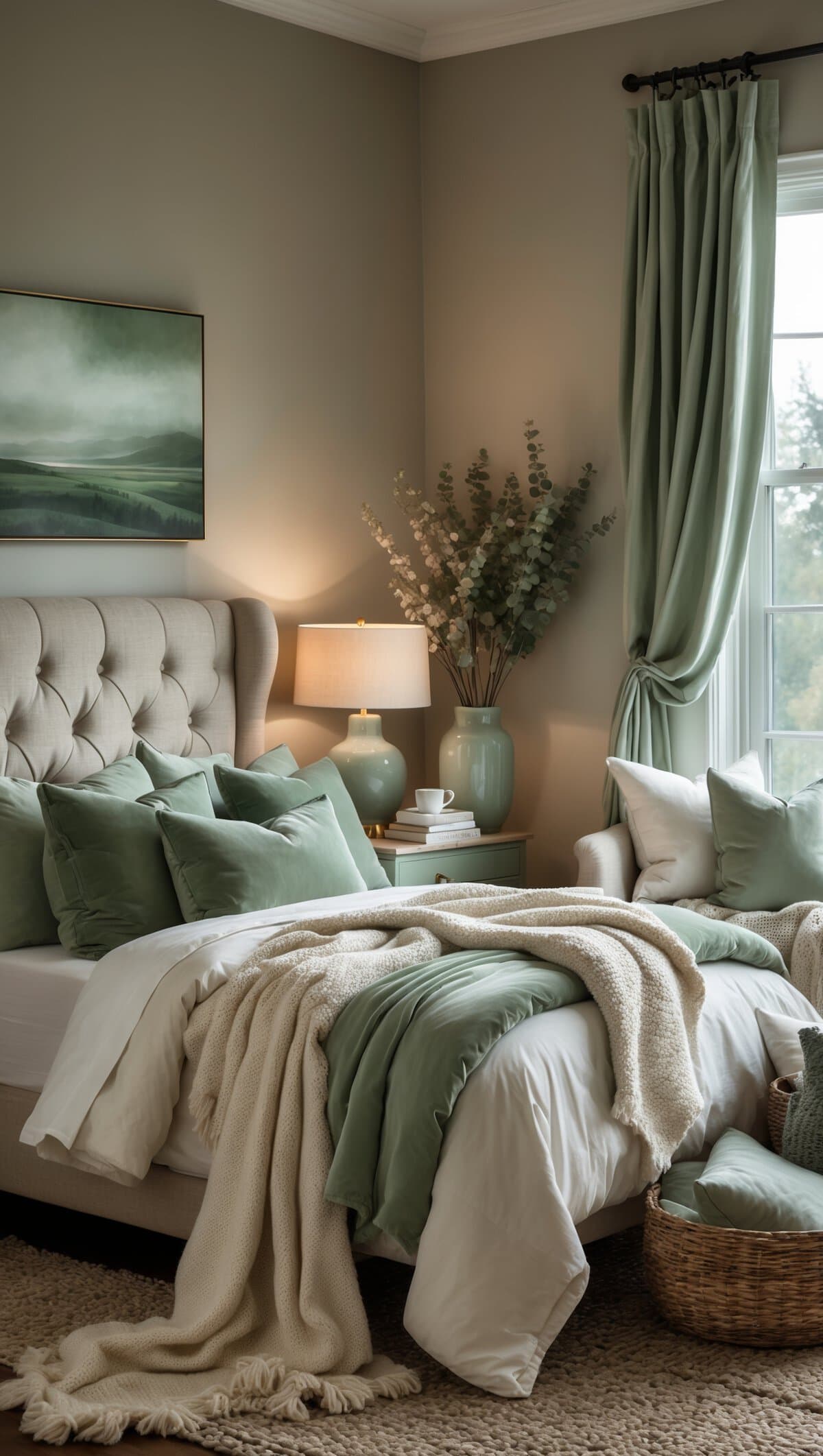
Picture This
In this calming retreat, walls in warm greige provide a sophisticated neutral envelope for carefully placed sage green accents. The bed, dressed in luxurious ivory linens, features two substantial sage green velvet pillows that immediately draw the eye. A sage ceramic lamp on one nightstand creates balance with a small potted plant with silvery-sage leaves on the other. A textural jute rug grounds the space in natural neutral tones, while a single large-scale photograph with sage undertones hangs on the main wall. The room feels intentional yet effortless, with each sage element standing out beautifully against the thoughtfully layered neutral background.
25. Japanese Wabi-Sabi Style Bedroom with Sage Green Slatted Walls
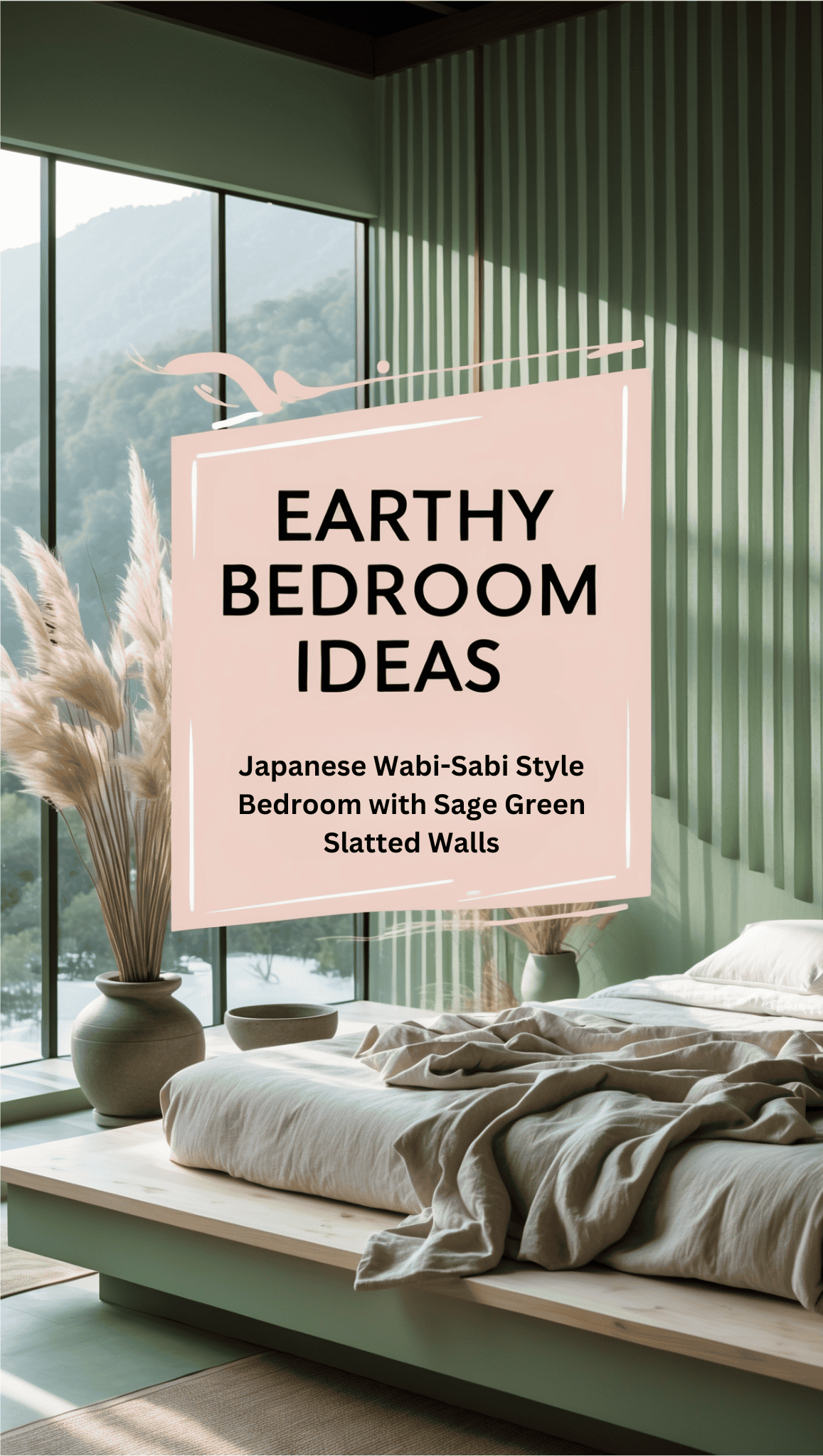
At a local art and design exhibition, I encountered a captivating display that beautifully reflected Japanese wabi-sabi design through the use of sage green slatted walls. This approach celebrates imperfection and the beauty of natural aging while referencing traditional Japanese architecture. The installation was striking in its simplicity, with the sage green color adding an organic element that seamlessly connected to the natural world.
What makes this arrangement so special is its ability to honor handcraftsmanship and natural materials while creating visual rhythm through the repetition of slats. The sage green deepens the shadows between the slats, echoing the moss-covered elements often celebrated in Japanese gardens.
Benefits of Wabi-Sabi Design
The wabi-sabi philosophy embraces imperfection and transience, creating spaces that feel authentic, calming, and free from the pressure of maintaining perfection.
Enhancing Architectural Interest
Slatted walls add tremendous visual texture and architectural detail while controlling acoustics and filtering light in beautiful ways.
Pairing Sage with Minimal Decor
The textural interest of sage green slatted walls requires very little additional decoration, allowing for the truly minimal aesthetic prized in Japanese design.
How to Recreate It
- Install wooden slats painted in sage green on one or more walls, with even spacing between each slat
- Choose a low platform bed, ideally made from natural untreated wood with visible grain
- Include only essential furniture with clean lines and visible craftsmanship
- Add bedding in natural, undyed fabrics like linen, cotton, or hemp
- Incorporate a single ikebana-inspired plant arrangement with mindful asymmetry
- Choose lighting that creates interesting shadow patterns across the slatted walls
- Include a small water element like a stone fountain to add gentle sound
- Maintain open floor space and minimal possessions, following Japanese principles of ma (negative space)

Picture This
In this wabi-sabi sanctuary, sage green slatted walls create rhythmic shadows that shift throughout the day, transforming the room with the sun’s journey. A low platform bed crafted from unfinished maple sits directly on tatami mats, dressed simply in rumpled linen the color of natural flax. A single asymmetrical arrangement of grasses and branches stands in a handmade ceramic vessel, while a small stone water basin provides gentle ambient sound. The sage green slats don’t try to hide their handcrafted nature—slight variations in color and spacing celebrate the human hand that created them, embodying the wabi-sabi appreciation for beautiful imperfection.
Final Thoughts

Incorporating earthy elements into your bedroom isn’t just about following a design trend—it’s about creating a space that nurtures your connection to the natural world. Each of these 25 ideas offers a different pathway to bringing the grounding qualities of earth into your most personal space. Whether you’re drawn to the subtle sophistication of sage green, the raw textural quality of natural materials, or the peaceful presence of plants, there’s an earthy bedroom concept that will speak to your aesthetic sensibilities while supporting your well-being.
What makes earthy bedrooms so timeless is their ability to transcend fleeting trends while creating spaces that feel genuinely restful. By surrounding yourself with colors, textures, and elements found in nature, you’re tapping into something deeply human—our innate connection to the earth that sustained us for millennia before modern life took us indoors. This connection isn’t just visually pleasing; research suggests it may actually improve sleep quality, reduce stress, and enhance overall mood.
As you consider which elements to incorporate into your own space, remember that authenticity matters more than perfection. The most successful earthy bedrooms reflect the personality and preferences of those who sleep there, not just a picture-perfect recreation of something seen online. Start with one element that genuinely speaks to you—whether that’s sage green walls, natural wood furniture, or a collection of plants—and build your earthy sanctuary one thoughtful layer at a time.
This post may contain some affiliate links. As an Amazon Associate, I may earn from qualifying purchases at no extra cost to you. Some products may have been gifted for testing and review. That being said, I only recommend products and services I genuinely believe in. Additionally, some content on this website may have been created with the help of AI.
Frequently Asked Questions
What colors complement sage green in the bedroom?
Sage green pairs beautifully with a wide range of colors. For a harmonious, calming palette, combine it with other earth tones like terracotta, ochre, and warm browns. For contrast, consider dusty rose, burgundy, or navy blue. Metallics like brass and gold create elegant accents against sage green, while neutral whites, creams, and beiges allow sage to be the star. When choosing complementary colors, consider the specific undertones of your sage green—some lean more gray, while others have yellow or blue undertones that affect color pairing success.
How can I incorporate earthy elements if I’m renting and can’t paint?
Even without painting, you can create an earth-inspired bedroom through textiles, furniture, and accessories. Start with bedding in earthy tones like sage green, terracotta, or oatmeal. Add natural material furniture where possible, or use slipcovers in natural fabrics over existing pieces. Incorporate plants, woven baskets, and natural fiber rugs that can move with you. Removable wallpaper in earth-inspired patterns or colors can create a temporary feature wall. Finally, consider picture ledges with framed nature photography or botanical prints to bring earthy aesthetic to your walls without permanent changes.
What’s the best way to maintain real plants in a bedroom?
To successfully keep plants in your bedroom, first select species that thrive in indoor conditions and purify air, such as snake plants, pothos, ZZ plants, or spider plants. Place them according to their light requirements, remembering that even “low light” plants need some indirect sunlight. Establish a consistent watering schedule based on each plant’s needs rather than a calendar, and always check soil moisture before watering. Consider humidity levels, especially in dry climates or during winter heating season, possibly adding a small humidifier. Finally, dust leaves regularly to maintain plant health and clean air benefits.
How do I balance earthy design with modern technology in the bedroom?
Creating a harmonious blend of earthy elements and necessary technology requires thoughtful integration. Consider dedicated solutions like bamboo charging stations or handcrafted wooden docks that align with your natural aesthetic. Hide cords using fabric cord covers in earth tones or tuck them behind furniture when possible. For larger items like televisions, consider furniture pieces with doors that can conceal them when not in use, or dedicate one modern wall while keeping the rest of the room earthy. Finally, establish technology boundaries in your bedroom, possibly designating it as a low-tech sanctuary with minimal devices for better sleep and stronger connection to your earthy design.
What are the best natural materials for bedroom furniture?
The finest natural materials for bedroom furniture combine beauty, durability, and sustainability. Solid hardwoods like oak, walnut, maple, and cherry offer exceptional longevity with proper care, developing beautiful patinas over time. Bamboo provides a sustainable alternative with natural antimicrobial properties. Rattan and wicker add textural interest while maintaining natural connections. If considering upholstered pieces, look for natural filling materials like cotton, wool, or kapok, with coverings in organic cotton, linen, or hemp. The best choice ultimately depends on your specific needs, aesthetic preferences, and environmental priorities, with solid wood pieces generally offering the best combination of durability and timeless appeal.
About The Author
Jahlila Violette Bastian is a Transformational Whole-Self and Wellness Lifestyle Empowerment Coach and the creator of The Tri-Sync Method. She helps women who feel stuck in the exhausting cycle of dieting, self-sacrifice, and uninspired routines reclaim their energy, confidence, and well-being—without guilt or overwhelm. You know what it feels like to keep pushing—taking care of everything and everyone—while your own needs sit on the back burner.
Maybe you’ve tried every diet, every routine, every wellness trend, but nothing sticks. You want to feel good in your body, connected to yourself, feel at peace in your home, and in control of your life—but instead, you’re exhausted, frustrated, and craving more. Ready to take the first step? Explore more at The Tri-Sync Method.Com
Don’t wait another day to start living your healthiest, happiest life. Schedule a Free Discovery Consultation with Jahlila today to explore how The Tri-Sync Method can transform your life. For additional questions or personalized guidance, please visit our Contact Page.


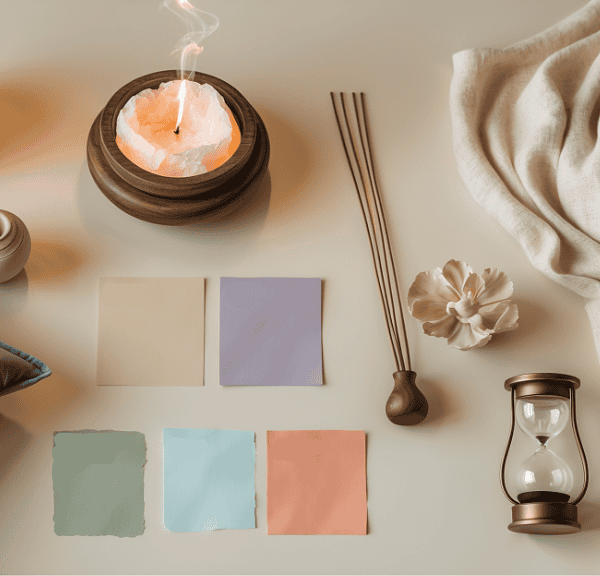

Leave a Reply